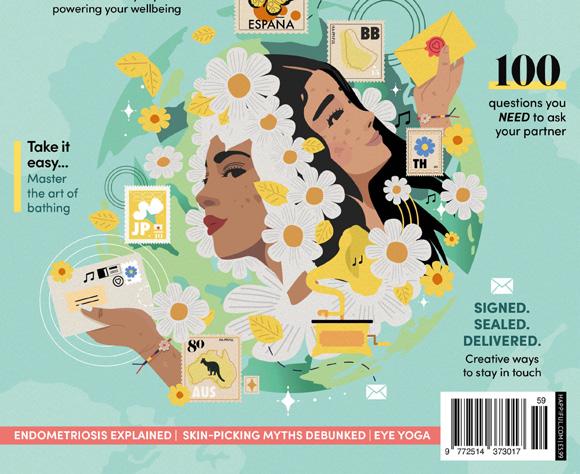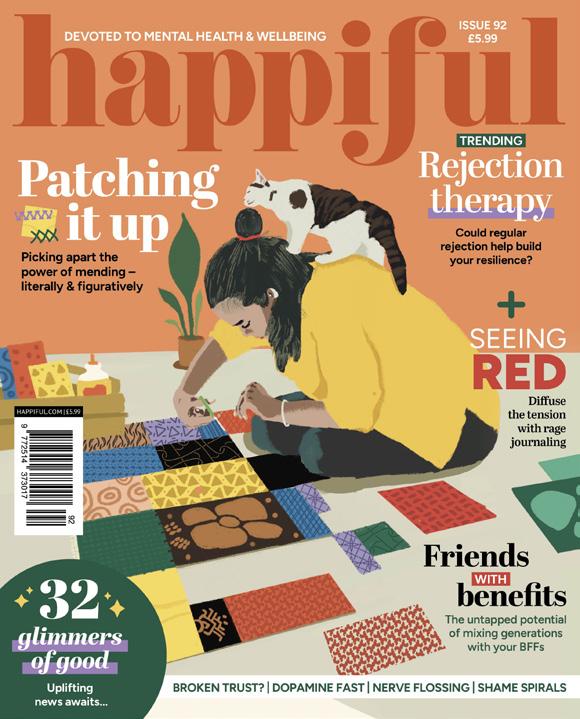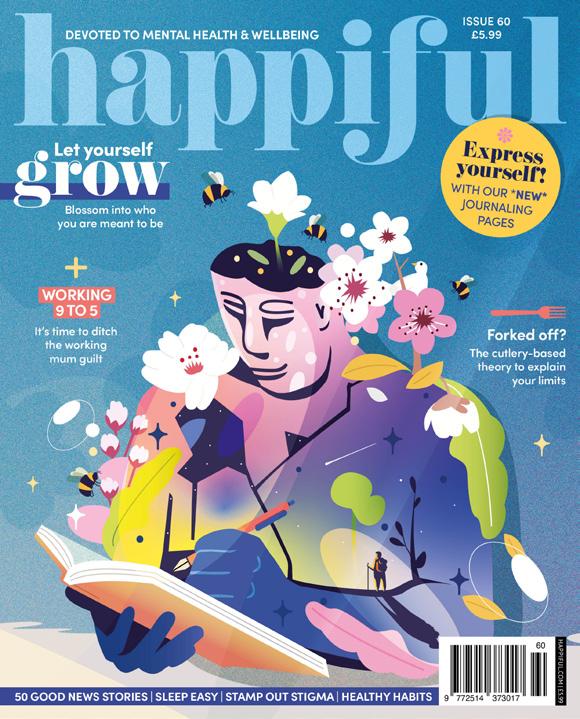Over the m n

Could
RAGE cleaning
Subconscious signs hidden under the urge to clean

Start where you are. Use what you have. Do what you can
Arthur Ashe


Could
Subconscious signs hidden under the urge to clean

Start where you are. Use what you have. Do what you can
Arthur Ashe
I recently found myself taking part in an ‘icebreaker’ activity with a new group of people. Initially, my heart sank at the idea of having to think up a lighthearted ‘fun fact’ about myself, but I need not have worried. Instead of the run-of-themill icebreaker topic, we were asked to share something we’d recently learned. A fascinating range of things came out as we went around the group – from the meaning of the word ‘biblioklept’ (someone who steals books) to a trick for making perfect roast potatoes. Conversation flowed, and the ice was genuinely broken.
Sharing information and being curious about the world around us can come with a real sense of wellbeing. In fact, the link has been confirmed many times over by scientists, with one recent study, published in Behavioural Sciences, finding that curiosity plays ‘a protective role in coping with existential vacuums’ – in other words, staying curious can help us to combat feelings of emptiness.
When it comes to cultivating curiosity, we have a lot to learn from children. Think back to childhood, and the things that fascinated you then. Perhaps you stood at the front of the class for ‘show and tell’ and enthusiastically told your classmates about your latest interest, or plucked a book off the library shelf at random and became absorbed in a whole new world. For some people, this curiosity continues throughout their life. For others, it can be rediscovered today.
Of course, curiosity doesn’t just apply to learning about the world around us, it’s also about turning our focus inside. For this issue, we’re bringing you a host of features that will direct your attention to both sides. Head to p49 to discover how the fairy tales we loved as children are being used in therapy to help us understand ourselves as adults, and turn to p15 to read our introduction to ‘skychology’ and the things that ‘looking up’ can do for us in our busy lives.

For some more practical curiosities, visit p44 to find out about the citizen science projects that you can get involved in. If you’ve ever thought of yourself as ‘uncreative’, this is the time to break free of that limiting belief with our guide to unleashing your ability on p42. Plus, learn about body doubling (p29), tips for dealing with high-functioning anxiety (p46), and find your personal journaling style (p65).
A commitment to lifelong learning is a commitment to an open, active mind. Within these pages, and out in the world beyond, seek it and savour it – you could be on the verge of a great discovery.

KATHRYN WHEELER | GUEST EDITOR

At Happiful, inclusivity, representation, and creating a happier, healthier society are at the forefront of our mission. To find out more about our social and environmental pledges, visit happiful.com/pledges
W | happiful.com
F | happifulhq
X | @happifulhq
I | @happiful_magazine
T | @happiful_magazine
Instead of scrubbing in anger, can
How looking up can offer us a fresh perspective on
21 How can anti-depressants affect our dreams?
Body doubling
We put this ADHD productivity strategy to the test
Fairy tale therapy
Can our favourite childhood stories reveal our hurt and help us heal?
19 Tips to reduce overwhelm
when you need breathing space 44 It’s not rocket science The super simple way you can support scientific breakthroughs 65 Find your journaling style
creative techniques to try 68 DIY spa day Have a budget-friendly pamper session

26 Tech boundaries Tips to maintain digital harmony in your romantic relationships 36 How to support a teenager who self-harms Wise words from adults who have been there themselves
39 Are UPFs really that



24 Ask the experts Ready to make a five-year plan?
Anxiety on your mind
tries a new form of therapy to tackle overthinking
Creative corner
time to shake off self-doubt
Expert column
Procrastination-busting with professional coach, Steve Maher 59 Myths, debunked The truth about living with chronic fatigue syndrome 62 Michelle Elman Reframing life’s lulls into moments that are worth savouring
46 High-functioning anxiety How to navigate the condition that’s often hidden behind success 71 5 steps to safety Effective exercises to help you recentre and feel secure
Sleep tips for ADHD 80 Tech-free retreat Lucy Pearson goes offline to address digital dependency
83 What makes you tick? Explore healthy habits, core
The wellbeing wrap
The impact of data poverty
Books of the month
Wellbeing refresh
Every issue of Happiful is reviewed by an accredited counsellor, to ensure we deliver the highest quality content while handling topics sensitively.
The complexity of relationships inevitably introduces challenges when it comes to communicating effectively –we are human, after all. And adding in the digital world can make things even more complicated. The relationships we have with others reflect the relationship we have with ourselves. Therefore, when presenting yourself digitally, it’s important to consider where your boundaries sit to ensure you feel comfortable (see p26 for tips). The integration of digital elements into relationships must be considered, as it holds great potential for deeper and more authentic connections.

Meet the team of experts providing information, guidance, and insight throughout this issue

ANITA GOHIL-THORP
LLB Dip.LC PCC MHFA FRSA
Anita is a coach specialising in wellbeing and positive mindset work.

LAURA O’SHAUGHNESSY
BSc (Hons) Dip.LC
Laura is a life coach who helps individuals find happiness, personally and professionally.
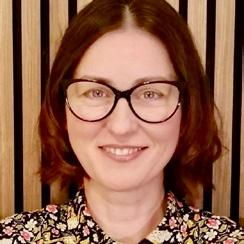
SMARANDA JIM MBACP
Smaranda is a counsellor specialising in relationships and couples counselling.

STEVE MAHER
MA Cert PCIC Dip.Psych MAC MHGI
Steve is a consultant, professional coach, psychotherapist, and writer.


BSc (Hons) MSc PhD MBPS MHCPC
Dr Suglani is a psychologist and coach, focusing on life, relationships, and ADHD.

BSc (Hons) CHP(NC) MCNHC MNCH
Thea is a trauma-informed clinical hypnotherapist and integrative therapist specialising in anxiety.

PRIYA KANNATH
BSc MSc PNPD MANLP MBANT MCNHC
Priya is a registered nutritional therapy practitioner, diabetes practitioner, and NLP practitioner.

EVIE WHITEHEAD
Dip.ION CNHC MBANT
Evie is a highly experienced nutritional therapist specialising in gut health.
Are you a wellbeing expert with valuable insight to share? Happiful professional membership includes opportunities to be featured in our award-winning magazine. Discover how to join by emailing us at professionals@happiful.com
EDITORIAL
Rebecca Thair | Editor-in-Chief
Kathryn Wheeler | Features Editor
Fiona Fletcher Reid | Features Editor
Lauren Bromley-Bird | Editorial Assistant
Bonnie Evie Gifford, Kat Nicholls | Senior Writers
Kate Norris | Content Creator & Writer
Michelle Elman, Steve Maher | Columnists
Ellen Lees | Head of Content
Adam Newey | Sub-Editor
Rav Sekhon | Expert Advisor
ART & DESIGN
Charlotte Noel | Creative Lead
Rosan Magar | Illustrator & Videographer
COMMUNICATIONS
Alice Greedus | PR Manager
Emily Whitton | Marketing Coordinator
CONTRIBUTORS
Jess Bacon, Becky Bowden, Caroline Butterwick, Ilona Cabral, Rebekah Crilly, Lucy Pearson, Karden Rabin, Katie Scott, Lydia Smith, Holly Treacy-West, Ruth Tullis, Lydia Wilkins, Laura O’Shaughnessy, Evie Whitehead
SPECIAL THANKS
Kanu Batra, Dr Maite Ferrin, Anita Gohil-Thorp, Georgina Hemsley, Smaranda Jim, Priya Kannath, Dr Faith Martin, Thea Martin, Dr Deepali Misra-Sharp, Laura Patterson, Dr Carmine Pariante, Alex Stark, Dr J Russell Ramsay, Dr Lalitaa Suglani
MANAGEMENT
Amy-Jean Burns | Chief Executive Officer Claire Vince | Chief Operations Officer
SUBSCRIPTIONS
For new orders and back orders, visit shop.happiful.com, or call Newsstand on +44 (0)1227 277 248 or email subenquiries@newsstand.co.uk
CONTACT
Happiful, c/o Memiah, Building B, Riverside Way, Camberley, Surrey, GU15 3YL Email us at hello@happiful.com
HAPPIFUL FAMILY
Helping you find the help you need. Counselling Directory, Life Coach Directory, Hypnotherapy Directory, Nutritionist Resource, Therapy Directory

A growing network of hospitals, doctors, midwives, and universities are committing to maternity and paediatric care without unnecessary plastics and toxic chemicals. As part of the groundbreaking Born Green Generation campaign, hospitals and universities in the UK and Europe have pledged to make the reductions during infants’ first 1,000 days.
Great Ormond Street Hospital is named as one of the hospital trusts piloting new sustainable ward models. Universities are developing models for healthcare students, while healthcare providers are testing new sustainable practices, including replacing plastic baby bottles with glass, washable diapers, and opting for reusable wipes.
The Born Green Generation campaign is calling on parents to

join the movement, and help phase out the excessive use of plastics and exposure to toxic chemicals, which can lead to severe and lasting health issues.
In the first 1,000 days (from conception to age two), infants are particularly vulnerable, and are currently exposed to many avoidable plastics. By 2030, the project envisions the first generation of babies born in healthcare settings free from
unnecessary plastics and toxic chemicals in more than a century. Using simple, sustainable alternatives can help minimise the impact on vulnerable newborns and the environment, with less waste being generated through a reduction of single-use plastics. A greener start for babies today means a brighter, cleaner future as every little change adds up to something big.
Writing | Bonnie Evie Gifford


A subtle but powerful wellness shift is sweeping across Britain, as new data reveals a nationwide preference toward earlier bedtimes and morning starts. The trend, observed thanks to Virgin Media O2’s network activity patterns, suggests that Britons are increasingly prioritising their wellbeing through altered sleep habits.
Virgin Media O2 broadband data suggests we are now going to bed 20 minutes earlier than in previous years, with network traffic consistently starting to drop off from 9.20pm. In comparison, 2020 traffic shows Brits going offline from 9.40pm. The recent data shows that the nation is rising earlier too; 2024 morning broadband traffic began to rise rapidly from 6.20am, which is 15 minutes earlier than in 2020.
Brits are also taking control of their wellbeing through meditation, perhaps to counteract the stress of being connected to the 24-hour news cycle. More than a third of Brits say the news is negatively impacting their mental health, but 44% have increased their mindfulness practices. In fact, almost two thirds (62%) have used their mobile phone to access mindfulness apps, and this figure rose to 88% for 18 to 24-year-olds.
As Britain embraces this collective move towards better sleep habits and regular meditation, perhaps a new dawn is breaking –one where technology and wellbeing work in harmony, helping to create a more mindful and happier nation, ready to face whatever challenges tomorrow may bring.
Writing | Fiona Fletcher Reid
The trial of a new programme designed to teach potentially life-changing emotional literacy skills to children with learning disabilities has yielded positive results for future research.
The randomised controlled feasibility trial, conducted by the University of Birmingham and funded by the National Institute for Health and Care Research, found that a larger-scale study is likely to show significant mental health benefits for children with learning disabilities.
Consultant clinical psychologist and associate professor in clinical psychology at the University of
MENTAL HEALTH
Birmingham, Dr Biza Stenfert Kroese, said: “Emotional literacy development in children with learning disabilities is often overlooked – despite evidence to show that it is protective of a wide range of negative outcomes, and leads to better mental health and quality of life.”
During the trial, five schools taught emotional literacy, while three schools used standard teaching programmes. Participants completed questionnaires to track changes in children’s emotional literacy, mental health, and behaviour and were interviewed about their experiences.
Since launching its new-look Mental Health Response Vehicles (MHRV) in December 2023, the West Midlands Ambulance Service has helped more than 7,200 patients gain access to specialist mental health paramedics, resulting in an 85% reduction in patients needing to be transferred to emergency departments. With the service supporting thousands of people in crisis, the vehicles are staffed by specialist mental health paramedics who have received additional training
in mental health practice. They are accompanied by either student paramedics or technicians, giving junior team members valuable experience handling mental health cases. The aim is to improve the quality and experience of care for those in need.
Richard Corrall, head of clinical practice mental health, says: “It is an incredible achievement to have been able to introduce and embed this service as part of our offer to our patients over the last year. My team has worked exceptionally
Dr Stenfert Kroese highlighted the significance of gathering data directly from the children who took part in the trial: “We are also delighted that we were able to ask children with learning disabilities to tell us themselves about their mental health by means of an adapted questionnaire. This has not been done before in this type of research.”
The findings indicated that some aspects of their mental health and behaviour had improved, but a larger-scale study is required to draw firm conclusions on its effectiveness.
Writing | Lauren Bromley-Bird

hard to develop new ways of working alongside the knowledge, skills, and experience that now make the difference every day to patients.”
As it progresses, the programme ensures that people experiencing mental health crises receive expert care when they need it most.
Writing | Fiona Fletcher Reid
Canada and Mexico have sent firefighters and technicians to California to help tackle the recent wildfire crisis
Believed to be the last video rental shop in the UK, TVL Allstar Video, in Suffolk, is still going strong after 40 years. With loyal customers coming in for daily chats, owner Colin Richards has broadened his offering to DVD repairs, plus photocopying and printing, too. With DVDs to rent for just £2 a week, the store shows that people still enjoy and want to support community spaces over streaming.
86% of Gen Z experience ‘menu anxiety’ when visiting restaurants, according to a survey by Prezzo
The UK government has confirmed plans to launch digital driving licences later in 2025
The launch of the world’s first wooden satellite, LignoSat, will help reduce ‘space junk’ as it will burn up on re-entry
Gerald Cooper, head of security and a fan favourite on Clarkson’s Farm, recently announced he is now cancer-free after undergoing treatment for prostate cancer, and has gone on to raise £28,500 for charity Prostate Cancer UK in less than two months, thanks to a racehorse syndicate initiative for ‘The Mullet’ (named after his infamous hairstyle).
Whether it’s kayaking, collecting, or calligraphy, a study commissioned by Hornsby Hobbies has revealed that 61% of Brits use their favourite special interests to boost their mental health, averaging five hobbies each. Additionally, it reported that 85% of those surveyed who engage with a hobby were happier than those without a go-to pastime to turn to.
Whether it’s from a show that makes you feel nostalgic, or an in-joke between friends, catchphrases from our favourite TV shows can be a great way to connect, and now a survey from Sky has revealed the nation’s top ones to repeat. “Lovely jubbly” from Only Fools and Horses was number one (37%), Homer Simpson’s “D’oh!” came second (25%), and “Here’s one I made earlier” from Blue Peter rounded out the top three (24%). But more modern options also made the list, with “I am a faithful” from The Traitors being a popular choice (15%). Interestingly, the survey also revealed a lot about culture too, and the impact of these shows, with 40% admitting they’ve quoted a line from a show they’ve never even seen!
The Biden administration has officially made history for its conservation efforts, covering 674 million acres of US land and waters, including 15 new, expanded, and restored national monuments.
A global study, published in Cell, found 300 new genetic risk factors for depression. Reviewing anonymised genetic data from 5 million+ people, across 29 countries, it offers a far more diverse look at risk factors, in order to get people help.
Raising a phenomenal £130K+ so far, James Cooper, 36, ran a marathon a day in 2024 to support Samaritans. Noting his own experience of depression, his goal was to support those struggling with mental illness, and, in particular, suicide. His endeavour saw him run 366 marathons in 366 days, ending this incredible feat on Tuesday 31 December.
Scientists have extracted a 2.8km ice core from Antarctica, with the drill actually managing to reach the bedrock beneath! This ice sample will offer unprecedented insights into our world’s climate history, dating back more than 1.2 million years thanks to air bubbles trapped inside.
It seems Brits have a taste for the exotic, with demand for papayas increasing by nearly 160% in the past year – making it the fastest-growing fruit (in popularity) in the UK.
Paving the way for a more ecoconscious future, it’s been revealed that 88.9% of cars on the road in Norway last year were electric –meaning the country is on track to hit it’s all-electric 2025 target!
It’ll be no surprise to their owners that cats are intelligent creatures, but a new study suggests they may even learn words faster than human babies! The study by Azabu University, Japan, discovered that our feline friends can quickly form links between pictures and words, suggesting our pets might understand us better than we think...
Is frantic dusting and tidying a good way to channel your frustration – or is it just sweeping the real problem under the rug?
Writing | Rebekah Crilly
You feel it building. The sight of mounting laundry and piling dishes is enough to tip you over the edge. You thrash around the house, slamming cupboard doors, tossing discarded items into their rightful places, muttering crossly to yourself things like: “Why is no one helping me?” “Am I the only one who can see this mess?” “Does anyone even care?” You are rage cleaning.
On the surface, it might appear healthy – cathartic even. An opportunity to release that built-up tension, with the added bonus of a tidy home. But what problem are you really solving? Is the mess the source of your frustration, or is there something deeper that rage cleaning was only masking?
Burnout coach and therapist
Alex Stark defines rage cleaning as “cleaning with a vengeance; a person’s inclination to clean as
a means to control their chaotic brain and space”.
It makes perfect sense; life is hectic and physical order frees up some of that cognitive mental load. Most of us strive for organisation, and research indicates the negative impact disorganisation can have on us, including symptoms of anxiety, a decrease in focus, and reduced working memory.
But this does not quite explain where our rage comes from. Of course, we might, in part, be triggered by the assault on our senses and the endless to-dos. But if we consider the second half of Alex’s definition, there is something further to be understood about the rage clean.
“It is usually referred to when used as a coping skill, when the person is displeased with their family’s participation in keeping the home clean, neat, organised, or tidy.”
As psychotherapist Laura Patterson says: “Rage cleaning
cannot happen in isolation. It is a relational issue.”
She urges us to look at what rage really is, in order to understand our actions that follow.
“Anger is not in itself a bad thing”, explains Laura. “It can be cleansing and, if channelled correctly, it can be productive.”
Where anger becomes problematic is when the source is not addressed. It is not an idle emotion that sits detached from an underlying cause.
“Anger and hurt are two sides of the same coin,” says Laura. She asked me to explore my own feelings around rage cleaning. What I assumed was just frustration, and an obsession with wanting things clean, was actually more to do with feeling unsupported, and a sense of imbalance. If I reflect on the monologue that runs on a loop while I’m vigorously scrubbing, it’s not actually “I hate this mess,” it’s “No one cares.” >>>

Mess can feel like a threat, but this form of anxiety is neurotic.

The mess stood as a visual representation of the hurt building. And while Laura notes that “a tidy space gives the illusion of a problem solved, nothing has actually changed”. Cleaning might eradicate the rage, at least temporarily, but it does not actually fix the hurt.
One study, published in the Personality and Social Psychology Bulletin, suggests that women might be more affected by clutter-induced stress than men, due to societal roles and expectations. Laura views this as part of the problem, and notes the impossibly high standards women create for themselves.
In her practice, she observes the narrative women have around what they think they should be. This is referred to as the “ego ideal”, and mess chips away at this. It serves as a visual reminder that you are not fulfilling your perceived obligations as a wife, mother, and woman.
“What idealised version of yourself are you holding yourself accountable to?” Laura says. “Are you setting the bar too high, and can you lower these expectations?”
Social media further fuels this, as we are constantly exposed to what appears to be the best version of others – the mess-free show home of the modern influencer.
While we’ve acknowledged how constant disorder yields its own problems, perfectionism can be equally harmful, linking to low selfesteem and poor mental health.
Our approach is key. “If people believe we are critical of them, they
Studies suggest that women might be more affected by clutter-induced stress than men, due to societal roles and expectations
won’t want to help,” says Laura. Essentially, we need to shift our stance from passive aggression to one of openness and honesty. Alex Stark suggests having “intentional conversations”. “This might be couples counselling or independently but, either way, we need to open the door to forgiveness in order to instil any behavioural change.”
Laura urges us to work productively together, and advises her clients to take stock on a Sunday evening. “What are all the tasks of the week ahead, and how can these be divided fairly? By both parties making this agreement, they are creating accountability.”
We can also look at taking other practical steps, such as doing one small cleaning task each day, and keeping at least
one room in the home clean so there is always a safe space we can go, even if the rest of the house isn’t as tidy as we might like.
Laura also wonders if we could learn to sit with the mess. She acknowledges that mess can feel like a threat, but this form of anxiety is neurotic. A messy kitchen does not call for a fightor-flight response. “We can achieve this by finding meaning in the mess,” she says. “What are the reasons for the mess? Is it because you have happy children using their imagination? Is it because you prioritise time together as a family over constant cleaning? These reasons are important.”
For me, personally, now that I better understand my rage cleaning, I feel more equipped to tackle it. Not just the mess, but the hurt alongside it.

In our busy, modern lives, we rarely cast our eyes to the heavens, yet recent research indicates that time spent looking at the sky can benefit our mental wellness
Writing | Ilona Cabral
Do you remember what the sky looked like today? Forget the weather, what colour was it at any point in the day? The sky is our constant companion, but how often do we actively look up and appreciate it?
When we are young, the sky is a magical, ever-changing canvas. There are pictures in the clouds and legends behind the stars. But, when we grow older, it can become as commonplace as a beige ceiling.
Noses in our phones, we forget to look up — and that is our mistake. The sky has such an immense impact on our lives. From the moment we look outside, a banner of dark clouds or a cornflower blue sky can make all the difference. Or at night, glimpsing the silvery trail of a shooting star can light up an evening.
Throughout history, human beings have been slowly migrating inside. With every passing generation, we distance ourselves further from nature. Think of the many ways that we used to rely on the sky. Rather than using phones or watches to tell the time, we would look up to the sun and the moon. Instead of GPS devices or maps, travellers would use the sky to plot their position and navigate. For so many people, the sky was at the heart of their stories, legends, and everyday lives.
For example, the ancient Greeks believed that the god Helios and his sister, the goddess Selene,
controlled the movement of the sun and the moon. Helios drove a golden chariot pulling the sun across the sky, and Selene drove a white chariot that pulled the moon.
The Scots nicknamed the northern lights the “Merry Dancers”, but the story behind this name is far from cheerful. They believed the dancers were “fallen angels” or “sky warriors” who were in the throes of battle. To them, the vivid blend of colours in the sky were signs of the action.
There are countless stories around eclipses, constellations, and solstices. Yet our increasingly comfortable, scientific, and pragmatic societies continue to separate >>>


us from the outdoors and its many myths and legends.
There has been significant wellbeing research recently examining the physical and mental benefits of getting outside in blue and green spaces, like forests, rivers, oceans, and lakes. Yet, ironically, research about our interactions with the sky has often been overlooked.
Psychologist and wellbeing researcher, Paul Conway, set out to resolve this gap, coining his area of study, ‘skychology’. Through his research, he examined the impact the sky has on our wellbeing, and what people experienced when they looked up. He found that, for many people, the sky was something both extraordinary and ordinary. It was a universal and constant companion which equally connects, amazes, and grounds us, and has significant potential to benefit our mental health through its calming and meditative effects.
In Paul Conway’s 2019 study, for the University of London, participants were asked to share their experience of looking up at the sky. Interestingly, Dr Conway noted that, though few study participants had openly discussed their experience of looking at the sky before, when asked, they shared significant responses about how looking at the sky had impacted their lives.
Each person expressed their admiration for the sky, and one described the sky as an infinite and frameless “piece of art”, which
ultimately prompted “existential questions about [their] place in the universe”.
Meanwhile, others knew in their core that getting outside would make them feel better and calmer in their selves. By actively looking up, especially alone, they found that the vast expanse “transcended [the] immediate”, putting things into perspective as they considered “the bigger picture”.
So, think back. When was the last time you had a meaningful conversation about the sky?
It is time to lift our heads and turn our eyes upwards. Here are some ways to reconnect with the sky:
The first step to appreciating the sky more is simply to see it more often. In our busy lives, it can be difficult to take the time to step outside, let alone go for a stroll and just stare upwards. On your next venture outside, leave your phone in your pocket and lift your gaze upwards for a few minutes. You might like what you find.
Sometimes things need to be seen from a fresh angle in order to be appreciated. Take it from a former high-ropes instructor, the world looks very different, depending on where you are positioned. Find someplace new to look up at the sky. You could climb a hill, take a trip to the ocean, or >>>

explore a different part of your village, town, or city. Just find somewhere that offers a different perspective from your everyday view.
Here is a challenge: over the next week, I want you to look up and notice the colour and texture of the sky. The Tate (UK institution including four art galleries) recommends spending up to 30 minutes looking at a painting to fully appreciate it. How long, then, should we spend looking at the sky, something which is everchanging?
One of the best ways to appreciate something is to try to recapture it. We all have different talents, so why not
channel your inner artist and capture the beauty of the sky. You could paint, photograph, or even write about the emotions it evokes.
There is something truly magical about watching a sunrise, sunset, or moonrise. To take the time to watch those colossal spheres rise up from nowhere, or disappear into the ether, and see the sky shift colours. Wherever we are in the world, we experience something similar, yet unique. In that way we are all connected. Watching the sunrise or sunset can actually reduce stress, as the colours can trigger the release of the feel-good hormone, dopamine. Sunsets also naturally signal the end of the day, helping you to regulate your circadian
rhythm, and lead to better sleep patterns.
Wherever you live, there are so many spectacular sky-related events throughout the year. There will be eclipses, meteor showers, full moons, and even the aurora borealis (the northern lights). Look out for these key events, and, by watching them, become more in-tune with nature.
Perhaps you will know a few more stories about the sky after reading this article, but there are plenty more waiting out there. Why not indulge in some fantastical stories, and learn more about the way different civilisations around the world have viewed the sky?
Productivity hacks and evidence-based techniques to shift your mind from chaos to calm
Writing | Fiona Fletcher Reid
When was the last time you felt truly clear-headed? For many of us, mental overwhelm has become the status quo. We’ve accepted the constant whir of thoughts, the endless to-do lists, and that nagging feeling of forgetting something important –but there are ways to lighten this mental load. Here are five tips to create a little breathing space:
1. Write about your problems
While it may sound counterintuitive, writing about the things that are contributing to the sense of overwhelm can have a positive effect. One clinical trial, published in the Journal of Clinical Psychology, found that expressive writing decreases intrusive thoughts and improves working memory, freeing up the mind for other mental activities. Start with a blank page and write whatever comes to mind, with no editing or judgment. Doing this daily can help clear out mental static before it accumulates.
2. Create dedicated focus time
According to a University of California Irvine study, it takes an average of 23 minutes to fully regain focus after an interruption
– so it’s no wonder that scattered focus can leave you feeling disorganised and unproductive. To minimise disruptions, pinpoint common distractions (such as phone checking, and email notifications) and block out specific times in your day to engage with these to preserve cognitive resources by reducing task switching.
3. Connect physically
Instead of isolating yourself, hugging or holding hands with a loved one could help. One review, published in the Personality and Social Psychology Review, found that physical touch can reduce stress and promote overall wellbeing. A randomised clinical trial from São Paulo University, in Brazil, also found that massage and Reiki can reduce stress and anxiety levels. So, whether you reach out to a loved one, or find a qualified practitioner on the Therapy Directory, human contact can create calm.
4. Try the two-minute rule
This is a concept from David Allen’s productivity book, Getting Things Done. His rule states that if the task that’s worrying you can

be completed in two minutes or less, you should do it immediately rather than adding it to your to-do list. Doing so means you avoid creating more future work for yourself, which soothes feelings of anxiety, and creates a sense of achievement.
5. Make a ‘no thank you’ list
Sometimes the sense of overwhelm is compounded by unnecessary tasks and responsibilities. Are there any activities or opportunities that you can say ‘no thank you’ to? It can be hard to say no, but the relief of taking something off your plate might be worth it. Create a deliberate list of activities, commitments, and mental patterns you choose to eliminate. This might include checking work emails after hours, attending non-essential meetings, or going to draining social events. Remember, saying ‘no’ to low-priority tasks is actually saying ‘yes’ to your wellbeing. By carefully selecting commitments that align with your mental health, you create space to focus on what matters most.

Happiness is not a possession to be prized, it is a quality of thought, a state of mind

Medication helps many to manage their mental health, but one side-effect could really be the stuff of nightmares…
Writing | Lydia Smith
One second you’re in your office, and the next you’re being chased by a stranger in the cafeteria of your old school. Nothing appears quite as it should be – the colours are brighter, the sounds are more jarring, and you wake up in a cold sweat.
Antidepressants are a lifeline for many people, myself included, but they can play havoc with your dreams. When I started taking sertraline – a selective serotonin reuptake inhibitor (SSRI) – my anxiety began to ease. But at night, my dreams became far more vivid than any I had experienced before.
For me, intense dreams aren’t a problem compared with the
struggle of daily anxiety. But why might antidepressants affect how you dream – and if they are disrupting your sleep, what can you do about it?
In a 2013 report published in Sleep Medicine Reviews, Gotthard G Tribl and his research team examined the impact of antidepressants on dream content. They examined 21 clinical studies, and 25 case reports, published over a period of 60 years.
The team looked at dream content across a spectrum of different antidepressants, including SSRIs and tricyclics, an older class of medications still in use today. SSRI antidepressants – as well as serotonin-
norepinephrine reuptake inhibitors (SNRIs) – were found to intensify dreams and increase the frequency of nightmares. Meanwhile, tricyclics tended to produce more positive dreams.
Different antidepressants work in different ways, but in general, they change the levels of chemicals called neurotransmitters in your brain. For example, SSRIs increase the amount of serotonin, which is associated with mood regulation.
It is these changes in brain chemistry that may affect how we dream, says Dr Carmine Pariante, a psychiatrist and >>>


When it comes to medications, ensure you always speak to your GP for advice and to discuss your treatment options. Never make changes without consulting them.
professor of biological psychiatry at King’s College London.
“Neurotransmitters like serotonin and adrenaline are involved in brain activity and circadian rhythms – 24-hour cycles that are part of the body’s internal clock – so it makes sense that medications that affect these chemicals also affect sleep and dreams,” he says.
However, the exact mechanism involved is unknown. Because these chemicals regulate emotions, increasing them could make dreams more intense. Pleasurable dreams may be more enjoyable – and nightmares scarier.
Serotonin and dopamine are ‘mood’ chemicals, but they also play important roles in the regulation of sleep, wakefulness, and transitions between sleep stages. A 2021 study, published in the International Journal of Molecular Sciences, found that SSRIs can increase the time between falling asleep and the onset of the first rapid eye movement (REM) sleep stage. So, it’s possible that these changes to our sleep stages can alter how we dream, especially with regards to changes in REM sleep – when dreaming and memory consolidation occur.
“Antidepressants tend to suppress REM sleep. But as the body gets used to the medication, there’s often a ‘REM rebound’ – a period in which the intensity and frequency of REM sleep increases,” says Dr Pariante.
This may result in more vivid and intense dreams. However, Dr Pariante adds, this rebound period is only temporary, and any sideeffects usually settle down as you get used to the medication. The impact on sleep also depends on the class of medication and the specific drug. “At first, tricyclic medications tend to have a sedative effect, which can help people sleep better,” says Dr Pariante.

“SSRIs have an activating effect, which is why people can experience an initial increase in anxiety,” he says. “But even if there is initially a negative effect on sleep, it’s likely this will improve as the medication has its intended effect. Antidepressants may also start helping someone sleep more deeply, affecting how they dream.”
One reason the relationship is so complex is because mental health problems like depression and anxiety can also cause vivid dreams – regardless of the potential effect of antidepressants.
“People with trauma or depression may have dreams with content that is really upsetting. There may be a direct reliving of a distressing experience, or a symbolic manifestation that you can interpret,” says Dr Pariante. One review, published in Sleep Medicine Reviews, also suggests that coming off antidepressants –which should be done gradually with medical guidance to avoid unpleasant or even serious reactions – can lead to an increase in nightmares and dream recall.
If your sleep is being negatively affected by your antidepressant regimen, there are steps you can

potential side-effects – and do not stop taking your medication. It’s vital to give antidepressants time to work – which can take at least one or two weeks – and to let your body adjust to the medication. “My first piece of advice would be to see how it goes,” says Dr Pariante. “The sideeffects, like nausea, go away after time and they improve.”
“If possible, take it in the morning rather than the evening, so the peak of the effect on the brain doesn’t happen during the night,” says Dr Pariante. However, the correct timing of your medication can depend on the type of drug you’re on, if you’re taking any others, and how many pills you take in a day.
An antidepressant that works well for one person may not suit another, so finding the right one can involve trial and error. “If the side-effects are really impairing and don’t go away in a few weeks, then you could try a different medication,” says Dr Pariante. “Even within drug classes like SSRIs, you may switch from one to another and the side-effects differ for individuals.”
If you’re struggling with nightmares, it may be helpful to speak to a therapist to address underlying stress or other problems
Making small changes to your evening routine may also help improve the quality of your sleep in general. Create a bedtime routine, and before bed do an activity you find relaxing, like reading or having a bath. If you’re struggling with nightmares, it may be helpful to speak to a therapist to address underlying stress or other problems.
Antidepressants can provide a really helpful way to manage a mental health problem, but like all medications, they carry side-effects. For many people, the benefits outweigh these – but if not, you can always speak to your doctor about trying a new treatment. The answer to a mental health problem isn’t always straightforward, but with the right support, it can be manageable.
How do I create a five-year plan?

Coach Laura O’Shaughnessy answers your questions on how to make an effective five-year plan
Read more about Laura (The Good Vibrations Project) on Life Coach Directory.
What is a five-year plan?
AIt’s essentially a roadmap for the next chapter of your life, both personally and professionally. To be both motivating and meaningful it needs to build towards a vision of where you want to be in five years. A beautiful image of your future life, one that you can cultivate in your mind’s
QWhat should be included in a five-year plan?
A It’s important to assess all aspects of your life that are affected by your vision. Typically, this means an audit and subsequent plan is needed for your finances, health, career, and relationships. Account for all the slices of the pie that make up your life, which is why a planning tool such as a ‘wheel
eye with visual references, feelings, and achievements. Your five-year vision is your North Star, and it’s the heart-led spark that stimulates the allimportant practical planning and groundwork.
A well-devised five-year plan can transform sketchy ideals and dreams into glorious, realisable goals. Undertaken with both
of life’ may help. A strong fiveyear plan features visions, goals and tasks, with target dates for goals and progress reviews. Here are three useful questions to ask yourself:
1. What changes need to be made and developments need to happen in all areas to get me where I want to be? Think about new skills you need to learn, conversations you need to have, places you need to go
passion and pragmatism, it will ensure that you don’t depend on tiresome New Year’s resolutions – the ones that dissolve by spring. Instead, you can thrive on purposeful plans, ones that form the backbone of your decision-making, driving you into directional action at every meaningful crossroad you take. and compromises you might need to make.
2. What does this look like in terms of actual goals, and how will I know when I’ve achieved these? Look at the measures of success and the costs involved to get there.
3. How does this translate into my daily routine? Consider the small steps you’ll take every day to get you closer to where you need to be.
help you need

QCan a coach help to keep me accountable?
AYes, a talented coach can make a whole world of difference to the accountability of your five-year plan. A study from the University of Scranton, Pennsylvania, found that only 8% of us who set goals actually achieve them. That’s a worrying statistic. It highlights that once a plan is made, we ironically find it easier to let life get in the way of the things we need to achieve
in order to live more meaningful, happier lives.
A coach can undoubtedly be a powerful game-changer. Coaches help you keep the dream alive and energise you into remembering why the effort is worth it. Your coaching ally can help you to identify the stepping stone goals to the other side of your river where your visions await. A coach will help slay dragons with you when things get hard. Most importantly, a coach will nonjudgmentally hold space for you every step of the way.
What are your top tips for building a five-year plan?
I think the most important thing is to enjoy the exercise, rather than treat it like homework or life admin. My top three tips are quite simply:
1. Keep it real. Build a plan that is both aspirational and exciting, but is also based on a reality that you can – and want to – create. Know your talents, and your capabilities, and ask yourself how they can propel you forward.
2. Keep it alive. Don’t hide your plan in a drawer or a folder on your laptop. Keep it close and remember to energise it with review sessions, adapting your plan to work with any real-life curveballs that will inevitably come your way!
3. Stay true to you. Design your best life, and not the one you see other people have. Tap into your values or ask a coach to help you. The greatest joy comes from living a heart-led life that is true to your own guiding principles.



Set your status to ‘success’ with this overview to achieving digital harmony with your partner
Writing | Fiona Fletcher Reid
The ping of a notification. Your partner's phone lights up on the coffee table. Should you take a peek? In an age where our lives are increasingly lived online, navigating relationship boundaries isn't just about physical space – it's about passwords, permissions, and privacy settings.
Digital boundaries relate to what you are comfortable with online. This might be around sharing your relationship status, ‘tagging’ each other in photos, or even what your expectations are around texting. It may also include discussions around who has access to your digital devices and passwords.
Couples counsellor Smaranda Jim explains why these boundaries matter: “Trust is fundamental to any relationship; without trust and respect there are no foundations on which to build a safe relationship.” With that in mind, here is a simple, yet effective, five-
step guide to creating healthy relationship boundaries around technology.
1. Check in with yourself
First, reflect on what makes you feel safe in a relationship, and how digital boundaries play a part in creating that comfortable environment. Consider questions like: how much of your relationship do you want to share online? Are you comfortable with your partner viewing your notifications? How do you feel about them following your friends on Facebook? Remember these are your boundaries, no one else’s, so you should set ones that feel right for you.
“The level of privacy should reflect the level at which the relationship is at,” says Smaranda. “After years within a safe, healthy relationship, you can consider sharing your passwords, for example. Doing that a couple of months in is not advisable.”
2. Start a conversation
Opening a dialogue about digital boundaries is crucial, whether you’re in a new relationship or a long-term partnership. Smaranda advises treating the conversation as a chance for both parties to state their needs: “As with any communication, be clear on what you need, and express that in a calm and respectful manner. Be prepared to listen well.”
Acknowledge how past experiences might influence your boundary needs, but remain firm about what makes you feel secure. “If you’re getting very emotional, or the other person is, agree to
take a break from discussions,” shares Smaranda. “Ideally reconvene as soon as possible to finish the conversation. It’s OK to not sort everything out in one go. This could potentially be a very emotive discussion, and both parties might need time to reflect, so it is understandable if it will happen over a number of days.”
Once you’ve defined the parameters, then comes the ongoing task of adhering to the boundaries. This means not only respecting stated boundaries, but also being proactive in maintaining them. For instance, asking permission before posting photos together, or reminding them that you don’t want them to use your digital devices. Speaking up in this way can set the tone for ongoing conversations around consent. “Everyone needs reassurance,” explains Smaranda, “and if the other person’s behaviour leaves you confused, then clarity has to be achieved via communication. Share your worries with your partner, open up about your concerns in a way that doesn’t sound like an attack, and listen attentively.”
If someone is monitoring your devices, tracking your location, demanding your passwords, constantly checking your online activity, or harassing you through digital channels, this isn't a boundary issue – it's abuse. Get free, confidential support at thecyberhelpline.com

Smaranda Jim is a counsellor specialising in relationships, dating, and couples. Connect with her via the Counselling Directory.
As relationships evolve, so too can digital boundaries. Technology is constantly changing, bringing new challenges to navigate. Pay attention to how comfortable you feel with your digital boundaries and regularly revisit the discussion, especially if a boundary is breached. If your boundaries are being tested, choose your moment carefully. “Find a time and a place when you’re both feeling OK, so not exhausted, unwell, very stressed, or hungry, and start by stating how having the boundaries crossed has made you feel,” says Smaranda. “Listen to the response without interrupting. As much as possible, ask additional questions if further clarity is needed.”
Setting and maintaining boundaries can be challenging, especially if there are trust issues or different expectations. Talking to a qualified counsellor or therapist can provide coping strategies and help you improve communication, work through any underlying issues, and find healthy compromises that respect everyone’s needs.
When life knocks you down, get back up again using these affirmations designed to help you keep on keepin’ on
My opinion matters | My mistakesdon ’tdefine me Ican andIwill|I am proudofmyachievements Ibelieve in mypotential

I believe in the person I am becoming | I choose confidence over self-doubt I am capable and in control | I let go of fear and welcome opportunities I am loved for the person I am


The productivity hack you didn’t know you needed
What is it about working alongside other people that boosts our productivity? And how can we get purposeful about this powerful pairing?
Writing | Katie Scott
Iremember there would be a giddiness to the newsrooms I used to work in as deadlines approached. Heads would be down, but we would all surface for air, have a chat about what we were working on, and plunge back into our articles. Now, I largely work at home and alone. As a mother, the flexibility is invaluable, but there are days where I
lack motivation. I miss the buzz of being around other people, but it’s also more than that. I miss sharing ideas, getting feedback, and being accountable within a team.
So, it was with that in mind that I found myself hurriedly climbing over piles of unsorted washing and ignoring the temptation to make another piece of >>>

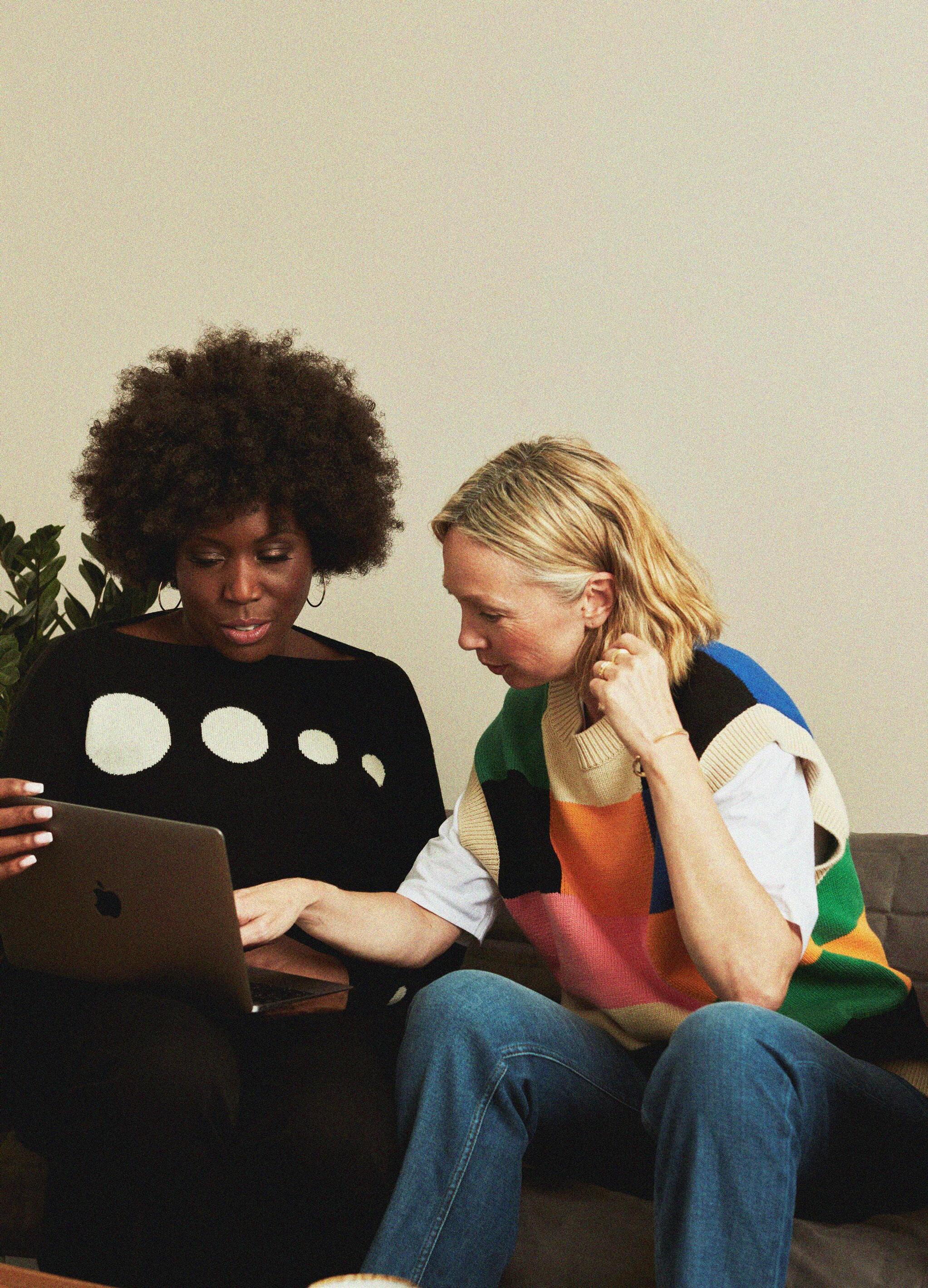
• Think about what you want to achieve that day, and home-in on what is realistic in that session. Break it down so that you can tick tasks off at pre-agreed check-in times. If you are happy working for longer spells, make sure the intention reflects this.
• Pick the right partner. Perhaps someone who you know will happily work alongside you quietly, and doesn’t need constant interaction.
• Be present. Work on a video call if you’re not in the same space. If you can be physically together, pick somewhere you can both have the space you need, but still be productive alongside each other.
toast to log onto a call with Anna Bartter, a friend and lifestyle journalist. We were going to test out a productivity strategy called ‘body doubling’. The idea is that you work on your own projects, but alongside someone else. This can be in the same physical space or online. There are now even websites like CaveDay, Flown, Focusmate, or Flow Club that you can log onto to body double with strangers.
The strategy first gained traction in helping people with ADHD. Dr J Russell Ramsay, founding co-director of the University of Pennsylvania’s ADHD Treatment and Research Program, has written extensively about its impact. He explains to me: “Body doubling is a form of externalisation of motivation. Because of working memory difficulties, adults with ADHD benefit from externalisation of information, such as recording appointments in a calendar or tasks on a to-do list that can be referenced later, rather than relying on calling them up in one’s mind.
“Agreeing to do something with someone else, such as walking, studying, or even virtual workgroups, adds a social element to the task that makes it much more likely an adult
with ADHD will follow through, show up, and thereby engage in a desired task.”
The strategy, however, has now gathered followers beyond its original sphere, prompting articles on news sites like CNN, and thousands of videos on TikTok. Dr Ramsay says this is because “being with someone else provides a cue to stay on task”. This cue is mirroring. Seeing someone else doing certain tasks activates specific neurons in the brain, so we are instinctively prompted to do the same. These mirror neurons were discovered by neuroscientist Giacomo Rizzolatti at the University of Parma, Italy, while studying macaque monkeys. He determined that these neurons explain how we learn through mimicry – but also why we empathise. In the journal Current Biology, scientists J M Kilner and R N Lemon wrote: “[…]The discovery of mirror neurons was exciting, because it has led to a new way of thinking about how we generate our own actions, and how we monitor and interpret the actions of others.”
It has also been suggested that body doubling can give us a dopamine hit as it’s the right kind of social interaction – one in which we feel empowered and supported. There are also theories that it taps into our instincts to perform better when we have an ‘audience’, or when we are working alongside people who we feel are high-achievers, which we then emulate.
For me, it provided an immediate catalyst to start my
day. I didn’t dawdle by the kettle, but was ready for the call – and had also thought about my intentions for my working day. I scribbled down which articles I needed to turn my attention to most urgently, and how much I wanted to achieve by lunchtime. Anna had done the same, so we kicked off our call with our goals and when we would check in with each other again. I was on a news shift while she had the gargantuan life admin task to tackle, which she had broken down into chunks. We agreed to check in after an hour, and got our heads down. I felt the familiar thrum of urgency that had been the base note of my in-house journalism career. I shut down my email, hid my phone, and got to work.
Body doubling works for everything from work to mundane tasks around our homes
I am not going to claim that I didn’t get distracted as we worked through the morning, but the strategy did make a huge difference. I hit my targets and also felt refreshed to crack on after talking to Anna at each check-in. These were brief conversations but we shared what we had achieved, had a little giggle, asked a few opinions, and then said what we were going to tackle next.
After three hours, we had a virtual cup of tea, and Anna admitted she had been pessimistic but also concerned that body doubling could be distracting. She added: “I also worried that I would find the pressure of you potentially being more productive than me intimidating.”
However, in the end, she was surprised by how effective it had been. “Rather than procrastinating for an hour, I knuckled straight down to the task I’d set myself, and I actually finished it. Every time I was tempted to start scrolling on social media or wander off looking for a snack, I was motivated by the thought of checking in with you. I wanted to be able to tell you that I’d ticked something off my list.”
This accountability was a huge driver for me, and was particularly effective for us as two people working in the same industry. But body doubling works for everything from work assignments to mundane tasks around our homes, argues Dr Ramsay and his team.
It seems that having an accountability buddy can make it easier to achieve our goals. The next step for our body doubling duo is a morning of working in the same space, and I wonder if it will be as easy to stay on track. I’m confident that the reward of a chat at the end of our session will keep me working, as will the drive to hit whatever goal I set myself because I’ll have shared it. And, it might just be the impetus I need to tackle the pile of unsorted washing before I let my friend through my front door.
What is it, who does it affect, and what can be done about it?
Writing | Kathryn Wheeler

How long could you go without access to the internet? Initially, it may be quite nice to unplug for a while, but it wouldn’t be long before you notice that certain barriers start to crop up. Online banking is off the cards, for example, and with Which? finding that 6,000 bank branches have closed in the last nine years, taking care of your
finances wouldn’t be easy. Communication might be difficult – both with friends and family, but also with service providers. Most jobs listings require online applications – as do schools and nurseries, and welfare and support services. And you can forget about finding contact details or helpful emails with ease. Very quickly, it would become clear just how
dependent modern life is on having enough data – so, what happens when you don’t?
‘Poverty’ describes when someone is unable to afford the necessities that they need to live, so the term ‘data poverty’ is about being unable to afford access to the internet. In 2025, data is such an essential part of life that having access to ‘appropriate technology’ is now recognised in the UN’s Sustainable Development Goals on ending poverty. Plus, in a survey by the charity Good Things Foundation, 61% of respondents said that internet access should become recognised as an essential utility, just like electricity.
According to the affordability tracker from Ofcom, about 6.8 million houses struggled to afford communication services in 2024, and 3.7 million households with children do not meet the ‘Minimum Digital Living Standard’ (accessible internet, adequate equipment, and the skills and knowledge needed to navigate digital services).
A report into data poverty in Scotland and Wales, from charity Nesta, found that people who are living in poverty have fewer opportunities to engage fully in the online world, with changes brought in since the Covid-19 pandemic only exacerbating this problem further, as entryways to many vital services now take place online. What’s more, the report found that the greater someone’s need for data, the greater the impact reduced access has on their life. For example, someone
who is unemployed typically will have a high data need because they need to search for and apply for jobs, but they are unable to afford data when they are without employment.
As with other forms of poverty, data poverty forces people to make difficult choices about what they spend their money on. In the report from the Good Things Foundation, one parent said: “Realistically, I choose paying for the internet over feeding myself, because the need is so massive for my children.” Another parent highlighted how data poverty impacted her son’s mental health, saying: “My 14-year-old son is struggling with depression and anxiety. Having data helps, he can listen to music or we watch a film together. Using the internet also helps me understand more of what he is going through, and how I can help him.”
Imagine a foodbank, but for data rather than food. The National Databank is run by the Good Things Foundation, and provides free mobile SIM cards and data packages for people who cannot afford to access the internet. Launched in 2021, the National Databank began with 34 hubs and – with the support of Vodafone and Three – expanded to more than 1,000 digital inclusion hubs in just one year. Today, more than 2,500 of these hubs offer National Databank, and more than 125,000 data packages are given to people who need them. What’s more, in 2024, Virgin Media O2 connected more than
6.8 million houses “ struggled to afford communication services in July 2024
223,000 people with O2 SIM cards since joining up with the Good Things Foundation, providing them with free data, texts, and minutes for up to 12 months. In addition to databanks, most libraries also offer access to the internet and computers. While in some counties this may be free, others may have a small charge in place. It’s worth noting you’ll often need to book in advance, and the time could be capped to 60 minutes.
As our society grows ever more digitally focused, data poverty will continue to be a problem for many people in the UK. Awareness of the issue, but also an understanding of how vital data can be in order for us to access services and opportunities, makes a difference to the culture around technology and data inequalities. This new way of life is often digital first, so as more people hit barriers in accessing data, this particular kind of poverty, and its solutions, have become important learning for all.
Find out more about the Good Things Foundation and data inequality by visiting goodthingsfoundation.org

Welcome to Anxiety on Your Mind, the series where we explore the reality of living with anxiety. In this edition, Ruth opens up about managing her mental health while caring for her dog, working, and running her business
Istarted the week with a shift in the gift shop where I work part-time. Although nothing out of the ordinary happened, I do find, generally, working in retail triggers my anxiety. I often mentally prepare for worst-case scenarios, like the shop being robbed, or overthink simple tasks, such as a quick trip to the toilet. Because I divide my week between working in the shop and running my online card business, my anxiety is exacerbated by switching between different tasks without rest breaks in between.
Strangely, I’ve found it more overwhelming since life has returned to ‘normal’ after the Covid-19 lockdowns. Back then, I had nothing to do other than focus solely on my business –and in some ways, that worked really well for me – but now distractions are everywhere. Whether it’s walking my cavapoo, Rosie, going to appointments, posting orders, or seeing family, life feels hectic. I’ve suspected for a while that I may have ADHD, and that this
might play a role in my inability to squeeze everything in. All the overthinking leads to paralysis, and then even small tasks feel impossible which leads to more overthinking. It’s a vicious circle! Although the anxiety is exhausting, I have accepted that it’s just part of who I am now. I’ve tried therapy in the past, but didn’t quite click with the therapist. However, recently, I saw a local therapist advertising ‘walk and talk’ sessions and I thought I’d give it a go.
So, on Tuesday, I took Rosie to the park and had my first appointment with my new therapist. One of my main stressors in life is juggling work and life admin, but doing therapy this way felt productive because it was killing two birds with one stone: walking the dog and accessing support.
It went way better than I could have hoped. She taught me some really useful tools, like naming and observing anxious thoughts instead of letting them define me. I’ve been desperate to learn some practical strategies, so I was really pleased with how that went.
During the week, I also helped my 92-year-old Nana run some errands. She can’t really hear or see, but mentally she’s very engaged. I loved getting to spend time with her, but I could feel my anxiety rising because I was responsible for keeping her safe, carrying her bags, and watching her closely to prevent a fall. The added cognitive load on top of my usual anxiety left me physically and mentally drained at the end of the day.
When I’m at home, my anxiety is less intrusive, especially when I have a long stretch of time with no visitors or outside obligations. Honestly, my ideal evening is doing some business admin on the sofa with Rosie by my side, then an hour of reading a good psychological thriller, followed by an early night.
It really boosted my wellbeing to get a full day at home on Thursday so I could focus on business tasks without interruption. It’s so rare that I get the sense of being productive and relaxed at the same time, so this was a good day. Of course, there

was still some anxiety bubbling underneath, but this was mainly because my neighbour informed me there was a public fireworks display scheduled the next day, and I knew Rosie would be unsettled by this.
I’m grateful that the neighbour is also a dog owner, because we made a plan to take a long walk together to tire the dogs a little ahead of the fireworks. I also knew if Rosie was really upset, I could take her round to my neighbour, and we could sit together to wait it out. Having company helps me feel less
alone in the anxiety. In the end, I played music to drown out the fireworks, and Rosie was fine which was a huge relief. It’s moments like these where I see the advantages of worrying, because it actually all worked out well due to my planning!
At the weekend, I spent time with my parents and Nana to celebrate her birthday. That was great because my family really understands my anxiety. There’s also some comfort in being around my parents, because I get to slip back into the role of being a child again. Shedding some of
my adult responsibilities, even just for a few hours, definitely helps me relax.
The week ended with something that always makes me anxious: selling my cards at a local market. There’s so much planning and preparation that goes into these events, and so much uncertainty around how it will go, it’s only natural to get nervous beforehand. I’m lucky that my parents help by looking after Rosie, and sometimes coming to the markets with me, so this one went without a hitch. It wasn’t necessarily a huge financial success, but the supportive atmosphere and lovely people I met made the day worth it. I’m learning to value these positive interactions alongside financial outcomes. Whether it’s leaning on my loved ones, finding the right support, or just having an early night, I’m proud of all I’m doing to manage my anxiety.
Five adults, who have been there themselves, share ways to support a teenager who self-harms
Writing | Jess Bacon
It can be difficult to know how to support someone who self-harms if you haven’t had personal experience with this yourself. Though anyone can engage in this behaviour, research has found that self-harm is most common in young people, with a 2021 study from the University of Cambridge finding that one in five adolescents are estimated to engage in some form of self-injury. There is also an increased chance of a teenager self-harming if they are a woman, neurodivergent, from a marginalised community, the LGBTQ+ community, or a lower socioeconomic background. When it comes to providing a safe space for a teenager, the most important thing is to be
non-judgmental and to listen to them. Kanu Batra, chief executive officer and co-founder of Speek, a platform that supports parents of children who self-harm, explains: “We’ve learned that parents play a crucial role in supporting a child who selfharms by fostering a safe, nonjudgmental environment where communication can flourish.
“Often, children find it easier to open up when they feel understood and validated. Many parents prefer using alternative strategies, like non-verbal communication or texting, when direct conversation feels too difficult.”
It can be hard to initiate these sensitive conversations, as well as offer practical support for overcoming this desire to harm


Things lose their power over you as soon as they’re spoken out loud
themselves. Here, five adults who self-harmed as teenagers, as well as experts and wellbeing professionals, offer their advice for navigating this difficult time together.
1. Encourage them to talk about self-harm
“My biggest advice would be to tell someone,” Fleurine, 27, says. “Find someone you trust and open up to them. Things lose their power over you as soon as they’re spoken out loud, and the burden becomes far easier to carry. People want to help you, so give them the chance.
“I did this with a friend and had a code word, so I didn’t even have to go into detail. She just knew to message me for a while, or even call, and get my mind off of it. Waiting just half an hour, or an hour, can be enough to make the urge diminish.”
When it comes to starting the conversation yourself, Dr Faith Martin, chief clinical research officer at Speek, says that curiosity is important during these conversations, as well as listening to what they’re asking for, rather than what you think they need.
“It can feel hard to create conversations at times, so be open, and when your young person talks, listen – be curious about their experiences, respect their experiences, and resist the urge to rush to solve,” Dr Martin
says. She suggests asking open questions like: what are things like for you at the moment? How can I best help? How can I best be here for you?
The main point she emphasises: “Listen more than you talk.”
2. Help them find an alternative outlet for their feelings
“The advice I would give anyone in the same situation is to really look at why you’re hurting yourself, and what you want to achieve from it,” Paul, 30, says. “For example, if it’s an outlet for rage, which everyone has, then it needs to go somewhere else. I would look at an outlet that people find gives them the release of self-harm without actually self-harming.”
Research published in Behavioural and Cognitive Psychotherapy has found that taking up a sport or new form of exercise is one of the most successful methods of breaking the cycle, as it offers an alternative way to work through your emotions and release them physically through movement.
3. Encourage them to explore sensory distractions
“For me, I found that having another less-destructive, yet physical, sensation really helped me,” Sarah, 35, says. “So things such as holding onto an ice cube until it melts, or flicking an >>>
elastic band against my wrist. I wish those tricks were there when I was younger.”
In her practice, consultant child and adolescent psychiatrist Dr Maite Ferrin advises that sensory distractions can offer healthier coping mechanisms that alleviate the desire to self-harm, and can help break the habit for good as they offer a substitute for the behaviour.
The activity can also be scaled to meet the level of the urge. For example, a medium level of holding an ice cube could be raised to taking a cold shower if you have a more intense desire to harm yourself.
4. Take up creative hobbies
“I’ve always loved writing, so I used to love pouring my heart out in my blogs about my mental health,” Andy, 47, says. “I got such a buzz from writing, I’d equate it to being like post-gym endorphins. I could guarantee that whenever I finished a blog, the urge to self-harm had dissipated somewhat.
“I also tried to motivate myself (when doing my A-levels) with the dream of getting a degree,” he adds. “I’d try to think about achieving this dream, and that if I kept self-harming then I’d be too ill to ever go, which kept me moving forward.”
This positive idealisation can help when you’re in difficult circumstances – imagining a
happy event taking place in the future to find a sense of purpose in your life in the present.
The charity Mind found that creative hobbies such as writing, painting, crafting, and playing musical instruments can help reduce stress, and instil a sense of purpose and fulfilment as you work to develop your skills. It’s a safe way to express your emotions and explore them in a constructive way that also offers you some enjoyment and distraction.
5. Spend time outside together
“One of the best things I did was start going on long walks with my dad or my family, and gradually opening up about how I was feeling,” Jen, 25, says. “I didn’t have to look directly at them, or read their emotions, or see their judgment – instead, I could talk and see where the thoughts took me, without feeling pressured to tell them everything while we were sitting next to each other on the sofa without an escape. The walking kept me calm and helped me to open up and get outside of my head for a while.”

For information, resources, support, and guidance around self-harm – for yourself or for a loved one – visit harmless.org.uk
the endorphins that come with moving your body.
Spending time outdoors has been found to have numerous health benefits, such as reducing stress levels, and improving your mood, self-esteem, and sleep quality. Alongside this, it’s a social way to spend time with loved ones while also getting some physical exercise, and
Dr Martin adds: “It’s important to recognise the underlying distress a teenager is experiencing. When we understand self-harm as their way of managing intense emotions, it helps guide how we respond. Validating their feelings is crucial. Just as we need others to empathise with our perspective, our teenagers need that same validation from us.”
We take a closer look at the processed foods filling our baskets, and the potential health consequences of consuming them
Writing | Fiona Fletcher Reid

Processed foods are part of modern life, but how much harm do they really cause? From pre-chopped carrots to microwavable macaroni, not all processed foods carry the same risks, but ‘ultra-processed foods’ (or UPFs) are more commonplace that you might realise – and understanding their impact on our health is more crucial than ever.
What exactly are ultraprocessed foods?
Almost all foods go through some sort of processing before consumption, and often this can have a positive result. Take frozen peas, for example. They are affordable, last a long time, and reduce food waste. Similarly, canned lentils are a convenient source of protein, and pasteurised
milk is safe to drink compared to the raw alternative. On the other hand, UPFs are complex food formulations created primarily from substances derived from foods and additives, with very few intact, whole food ingredients. Unlike traditional cooking methods, UPFs incorporate ingredients not typically used in home kitchens. While they might include familiar elements like sugars, oils, and salt, they also contain highly processed ingredients such as hydrogenated oils, hydrolyzed proteins, maltodextrin, and high-fructose corn syrup.
This kind of food processing becomes harmful when it reduces nutritional value, adds excessive sugar, salt, or unhealthy fats, or includes harmful substances. For example, refined white bread
loses fibre during processing, and processed red meat can increase risk of bowel cancer by 32% and colon cancer by 40%, as noted in a 2020 study in the International Journal of Epidemiology.
If you eat a lot of UPFs, it’s not necessarily your fault. Foods like cookies, crisps, and frozen pizzas are often engineered to be ‘hyper-palatable’ which makes them tasty, lacking in nutrients, and more likely to be consumed in large quantities. Artificial colours, flavour enhancers, non-sugar sweeteners, and numerous chemical agents are often designed to improve texture, appearance, and palatability. The ultimate goal is to produce convenient, attractive, and profitable products that are designed to be irresistible and long-lasting. >>>
Examples of UPFs include:
• Baked food items such as cakes, pastries, and cookies
• Salty snacks like pretzels and crisps
• Processed meats such as bacon and salami
• Ready meals, frozen pizza, and ready-to-eat burgers

Eating packaged and processed foods is rooted in our modern culture
Confusingly, many foods labelled or advertised as ‘low fat’, ‘organic’, or ‘natural’, can often be heavily processed, even though they are assumed to be a healthier choice. This misleading phenomenon is known as the ‘health halo’ and is something to look out for.
What is the real problem with UPFs?
The health impact of UPFs is challenging to define, because of complex individual factors like genetics, lifestyle, and metabolism. This makes it difficult to prove the relationship between UPF consumption and certain health outcomes. However, there’s emerging research that can act as a guiding light. In one 2022 study of more than 10,000 American adults, published in Public Health Nutrition, the more UPFs participants ate, the more likely they were to report mild depression or feelings of anxiety. In Brazil, a 2022 study in JAMA Neurology that followed nearly 11,000 adults over a decade found a correlation between eating UPFs and worsened ability to learn, remember, reason, and solve problems. A high-level evidence review, published last year in the British Medical Journal,
concluded that higher exposure to UPFs is associated with an increased risk of 32 damaging health outcomes including cancer, major heart and lung conditions, and mental health disorders, as well as early death.
How can we begin to limit our intake of UPFs?
Trying to completely eradicate UPFs from your diet is difficult because of how widely available, convenient, and addictive these foods are. If you’re concerned about the impact of UPFs, registered nutritional therapy practitioner Priya Kannath suggests starting by focusing on adding fresh, quality produce to your basket, and making healthy substitutes wherever possible.
However, it’s important to still be realistic about how many changes you can make. “Eating packaged and processed foods is rooted in our modern culture,” says Priya. “Therefore, completely avoiding them would be a hard task for many people to achieve.
“Not everyone will have the time or patience to make their yoghurt or bread at home daily. It is important to differentiate between minimally processed food that is nutritious, and ultra-processed food that contains various chemicals and calories. Clearly,
not all processed foods are made equal, and not all are harmful.”
This means taking time to read the labels on packaged foods to look for added chemicals like colourings, flavourings, emulsifiers, thickeners, stabilisers, and other additives. You can also use Open Food Facts (world. openfoodfacts.org) to access a food database where UPFs are clearly labelled. Alternatively, checking the ingredients list before you make a purchase can help. “Check whether you can recognise the names of these substances,” says Priya, “or whether they are ingredients you would typically find in your kitchen cupboard.”
The allure of many UPFs is the convenience factor. To combat this, try batch cooking using fresh, healthy ingredients, and storing them in the fridge or freezer to ensure you have quality food within reach. Meal planning will help you make a shopping list, ensure a variety of healthy food, and avoid impulsive buying. By gradually shifting towards minimally processed alternatives and treating UPFs as an occasional occurrence rather than typical everyday foods, you can nurture both your health and your enjoyment of eating. The journey doesn’t require perfection – just conscious choices, and a proactive approach to nourishing your body and mind.

Priya Kannath is a registered nutritional therapy practitioner, diabetes practitioner, and NLP practitioner. Reach out via the Nutritionist Resource.

M“But I’m not creative!”
Give yourself permission to be an artist and uncover the benefits of self-expression
y friend tells me about a painting class she’s been going to. Part of me is tempted to join her, but then I find myself saying, “That sounds lovely, but I’m useless at art.”
Does this sound familiar?
Whether it’s singing, sewing, painting, or pottery, you may find yourself flinching at the idea of trying new things. The truth is, I’d love to go along to an art class, but my inner critic tells me I would be awful at it. In some ways, I very much see myself as creative – I write, and I studied creative writing. Yet, despite the fact the word ‘creative’ is literally in the name of my degree, I still sometimes feel resistant to describing myself as creative, and find myself reluctant to try many other activities.
Whether you have an artistic hobby, or describe yourself as ‘just not creative’, it’s understandably hard to try something that takes you out of your comfort zone. But tapping into this side of ourselves can be so worthwhile.
“Creative activities – whether it’s painting, writing, knitting, baking, or even gardening – offer a chance to step away from life’s busyness,” says life coach Anita Gohil-Thorp. “They invite us to be mindful and present, using our senses in ways that feel grounding. In today’s
Writing | Caroline Butterwick

tech-driven world, creativity also provides an opportunity to unplug from screens, giving our minds a much-needed break. While technology and AI have made creative tools more accessible, going offline for hands-on creative activities can enhance relaxation and focus. In turn, this can promote energy for other daily activities and demands, as well as clarity and effective concentration.”
Anita highlights how creativity can help with everything from social connection and relaxation to exploring different sides of ourselves. “By reconnecting with our creative side, we not only nurture our wellbeing, but we also uncover our hidden joys and strengths,” she adds.
So, despite the benefits, why is it common to question our creativity? “Often, the belief that we’re ‘just not creative’ comes from a narrow and misplaced definition of what being creative means,” Anita explains. “The problem is that creativity is often linked to exceptional artistry, whether in art, music, cooking or another creative field. When we define it this way, it can feel intimidating and unattainable, leading us to believe there’s no point in trying. The comparison is
unrealistic, yet it stops us before we even try.
“Many of us are also conditioned to think of creativity as an inherent trait, something you’re either born with or not,” adds Anita. “If, as children, our creative efforts were undervalued, negatively compared to another child’s or dismissed as impractical, we may have learned to suppress that part of ourselves. Over time, negative self-talk and a lack of opportunities for creative expression reinforce the idea that we’re simply ‘not creative’.”
Perfectionism can contribute, too. “Perfectionists often set unrealistically high expectations for themselves, which can lead to constant self-doubt,” says Anita. “This harsh self-judgment, combined with a fear of not meeting their own standards, can stop them from stepping outside their comfort zone to try creative activities. Not only are they highly critical of themselves, but they can also be held back by the fear of being negatively judged by others.”
This rings true to my fears about picking up a paintbrush – not only am I worried about letting myself down, but also of being seen as not good enough by others. It feels a little sad to think that this selfdoubt has stopped me from doing enjoyable activities. So, how can we move forward?



“Changing how we define creativity is essential,” Anita tells me. “Creativity is not just about innate artistry – it’s a skill that can be nurtured and developed in a diverse range of activities. Embracing this broader perspective can help us reconnect with our authentic selves and improve our overall happiness and wellbeing.”
Shifting our mindset can help too. “As adults, we can reflect on our patterns of thinking and learn self-acceptance. We can embrace that creativity is not about perfection, it is about curiosity
and self-expression in novel ways,” Anita says, explaining how letting creativity be about the process, not the outcome, can help. Being creative on your own – like writing a poem without feeling the pressure to share – can be a way of gently getting in touch with your creative side with less worry about perfectionism.
“Starting small and taking the pressure off, for example, by accepting you are a beginner is also helpful. In coaching, we talk about giving ourselves permission – giving yourself permission to create just for the sake of creating,” says Anita. “Try activities that feel manageable (not hard work or requiring new equipment) such as an adult mandala colouring book or an enjoyable activity you used to do as a child.”
Trying a range of different things can help you tap into what speaks to you. “For example, after trying sewing, baking, singing, colouring, or painting, you will notice what you naturally gain joy from,” says Anita.
Anita recommends getting in touch with how we were creative as children. I think about how much I loved art as a child, the sketchbooks full of drawings, the pots of paint spread across the dining table on a rainy Sunday afternoon. I used to take joy in expressing myself, in getting messy, in having fun without the pressure of creating a masterpiece. I smile at this memory and then I text my friend. I ask when the next painting session is, and tell her I’ll be there.
To truly help our planet, we need to connect with it. And the good news is you don’t have to be a qualified expert to support the cause. Enter: citizen science...
In life, taking stock of where we’re at helps us decide on a path forward. This could be a financial audit to understand our spending habits and build a budget, or a wellbeing one to assess the areas of our life that need improvement – but what about the state of our world?
Naturally, scientists can’t be everywhere all at once, so how can they actually know what’s going on in real-time with the environment or the animals inhabiting it? The solution could just be in our own back gardens.
Citizen science projects encourage all of us to take action to support a cause, with no scientific background or research degree required. They ask volunteers to gather data on a larger scale, harnessing the power of the public and community spirit, which enables conservationists and scientists to get unique insights into spaces they wouldn’t typically have access to.
The more information gathered the better, so whether it’s counting birds, butterflies, or signs of blossom, these projects ask as many people to get involved as possible, teaching us about population figures and behaviour patterns to identify trends, along with any concerns.
But the benefits go beyond improving our understanding of the natural world. Citizen science schemes not only educate the general public and connect us with our local area, but also empower us to aid the future of our planet – from changing our own habits to better support the environment to advocating for positive change, as well as bringing in fresh perspectives to assist with scientific breakthroughs. And, the best part is citizen science projects are easy to support – you can even take part from your own home or local area. Most require monitoring a space for a period of time, which can be a mindful activity in itself as you focus on the moment. Ready to get stuck in? Here are some of the many incredible projects looking for volunteers:
Taking place between 18 July and 10 August in 2025, involvement in this project run by Butterfly Conservation is more important than ever, as the 2024 results led the charity to declare a butterfly emergency with numbers dropping significantly since the 1970s. The charity notes how butterflies act as biodiversity indicators, which means they
respond quickly to changes in the environment, and therefore are key in recognising what’s happening in our natural world. Supporting this initiative couldn’t be more simple; participants are asked to spend 15 minutes each day recording butterflies they see, either via their website tracker or app. There is also a handy guide to help you identify different types, plus targets to watch for. Head to bigbutterflycount.butterflyconservation.org to join in.
This biannual campaign from the FreshWater Watch aims to assess water quality across the UK. The next one runs from 25–28 April 2025, and asks volunteers to test the water quality in local freshwater sources, such as rivers, streams, and lakes, and with the results from the September 2024 campaign painting a bleak picture, this is more important than ever to encourage action. The report revealed that 61% of water sources across the UK showed poor water quality, with the worst seen in the Anglian and Thames river basin districts, where 80% of samples showed ‘unacceptable nutrient concentrations’.



To help in the upcoming campaign, simply register your interest at earthwatch.org.uk/ greatukwaterblitz to receive more information, along with your own water testing kit.
The Big Garden Birdwatch
Organised by the RSPB, the world’s largest garden wildlife survey runs in January each year, and asks volunteers to sign up to simply watch their gardens for an hour each day, recording the avian creatures they see. In 2024, more than 600,000 people
took part in the UK, and recorded an incredible 9.7 million birds –from blackbirds to blue tits, and house sparrows. But beyond a mindful pastime, recording this data is essential to help scientists track the challenges facing birds in general, along with specific species – noting that we’ve seen a loss of 38 million birds in UK skies in the past 60 years. Visit rspb.org.uk for more details.
Noted as the “longest written biological record of its kind”,

• Zooniverse (zooniverse.org) is a platform connecting researchers with volunteers, all over the world.
• The Wildlife Trusts (wildlifetrusts. org/citizen-science) runs projects across the UK, including region-specific ones.
• Earthwatch Europe (earthwatch.org.uk) connects people with nature through a range of projects.
this initiative by the Woodland Trust looks to track seasonal shifts and patterns, to see how climate change is affecting our ecosystems. The easy, three-step process requires you to pick a species and behaviour (such as tracking common frogs and their first spawn of the season, or spotting certain fungi), decide the area you’re recording (e.g. your garden, or a particular public location), and make a note on the online system of the dates of these actions. Get involved by visiting the woodlandtrust.org.uk
Not all anxiety is created equal – some forms will have you believing that you’re thriving…
Writing | Holly Treacy-West
Organised, driven, and calm under pressure: if this sounds like you, they might be qualities you’re proud of or even traits you’ve been praised for. Yet, these same qualities could signal highfunctioning anxiety (HFA) – a unique form of anxiety that often hides behind a veneer of ‘having it all together.’
HFA is a silent challenge, where individuals may look calm and collected on the surface, but experience a whirlwind of stress and worry underneath. If this sounds familiar, you’re not alone, and there are tools and strategies that can help.
Dr Lalitaa Suglani, a worldleading psychologist, leadership coach, international speaker, and author of High Functioning Anxiety, shares how we can manage HFA with greater awareness and ease.
According to Dr Suglani, HFA is often hard to identify because individuals experiencing it tend to push themselves to excel, masking their inner struggles. “While they meet their goals and maintain relationships, they may also grapple with fear of failure,
overthinking, and an inability to relax, often experiencing symptoms like racing thoughts, physical tension, and insomnia,” she explains.
Dr Suglani emphasises that although HFA may be less visible, it is very real. “With mindful strategies and support, it’s possible to manage these challenges, and lead a balanced, fulfilling life,” she says. So, how can we put that into practice?
HFA often thrives on a relentless stream of ‘what if’ thoughts: what if I can’t get through this presentation? What if I don’t pass this test? What if they don’t like me? What if I’ve made a huge mistake? These looping questions can feel overwhelming and keep the mind stuck in worst-case scenarios. Dr Suglani suggests practising regular mindfulness exercises to break this cycle. Techniques such as deep breathing, body scans, or brief meditation sessions can help shift your focus from future fears to the present moment, grounding your thoughts and calming an anxious mind.
Ah, boundaries. Most of us know we should set them, yet putting them into practice can be easier said than done. But taking time to understand your needs and align them with your values is key to establishing boundaries that support your wellbeing. However, Dr Suglani shares that people with HFA often struggle to say ‘No’, leading to overcommitment and stress.
“Learning to prioritise tasks, delegating when possible, and setting clear limits can prevent burnout and help maintain a healthier balance,” she says. Remember, boundaries aren’t about saying ‘no’ to others, they’re about saying ‘yes’ to yourself and your needs.
Something that goes hand-inhand with the ‘what if’ train of thought is perfectionism. We often believe that if we do everything flawlessly, we’ll finally feel secure, or achieve our goals. But here’s the kicker: because this is based on your own high standards, the goalposts are always moving. Dr Suglani
suggests that instead of striving for perfection, aim for progress. “Remind yourself that mistakes are part of growth, that every small step counts, and that your worth is not dependent on a flawless performance.”
Schedule relaxation time
For someone with HFA, relaxation might feel like a waste of time when you could be striving toward productivity and perfection. But Dr Suglani suggests treating relaxation as essential, just as you would schedule work or personal commitments. She recommends setting aside time for genuine relaxation and hobbies – not reading to fuel a BookTok account or candle-making as a weekend side hustle, but true time to switch off and simply be. “Engaging in enjoyable activities can help shift your focus away from stressors, foster a sense of calm, and boost overall wellbeing,” Dr Suglani shares.
Seek professional support
Reaching out for help might feel daunting, or even unnecessary, if you believe you’ve got it all together. However, Dr Suglani shares that therapy can provide valuable tools for managing anxiety. Even if you’re not experiencing obvious symptoms – like a racing heart or sweaty palms – chronic tension, a whirring mind, and trouble sleeping aren’t normal either, and they deserve attention.
“Working with a mental health professional can help you identify and understand

We often believe that if we do everything flawlessly, we’ll finally feel secure
underlying triggers and patterns, develop healthier ways to cope, and build resilience,” she says, emphasising that support can make a meaningful difference.
We’re not suggesting that being competent and accomplished isn’t worth striving for. But if your achievements are coming at the cost of your mental health, it’s worth considering if underlying anxiety might be driving your need to succeed. If you’re only showing others the good side and hiding your anxious self, there may be more self-doubt than selfconfidence beneath the surface. These tools are here to remind you that you really are good enough, just as you are.

Dr Lalitaa Suglani is a psychologist and coach, focusing on life, relationships, and ADHD.Get
in touch via the Counselling Directory
Whether you’re out and about, at work, or at home, use these quick and easy grounding exercises to find your calm
Do a body scan
Bring your attention to the top of your head. Slowly, shift this focus down your body, consciously relaxing each part as you go until you reach your toes.
Count your blinks
Don’t force them, but count each blink you naturally have. You could either do this for one minute, or keep going until you reach a certain number of blinks.
Hold something cold
It could be an ice cube, a cool stone, or even a crystal. Whatever your choice of object, hold it in your hand and focus on the sensation until it slowly warms up to body temperature.
Play ‘I spy’ with yourself
Set yourself up an ‘I spy’ challenge. Perhaps looking for everything in the room beginning with a certain letter, or everything made of wood, or the colour blue, etc.

Plant your roots
Either stand or sit with your feet planted firmly on the ground. Close your eyes and imagine roots running from your feet, connecting deep into the earth below you.
Get curious about how far you can hear
What’s the furthest away sound you can hear? Is it chatter in the next room, or the distant rumble of traffic? Tune-in and listen.

Writing | Rebekah Crilly
She asked me what my favourite fairy tale was. I responded, with no thought required: The Little Mermaid. She probed a little further. “And do you ever struggle to find your voice?” There it was, like a big cartoon anvil to the head. I assumed it was just because I liked Ariel’s lush red hair, or because I was smitten with the leading man but, it turns out, there might be more to this bias than I ever considered.
The ‘she’ I refer to is psychotherapist Laura Patterson, who specialises in using
the creative to uncover the unconscious mind. “Fairy tales provide rich imagery which the unconscious mind can connect with and relate to,” she explains. “They serve as a container for the unconscious and, once opened, allow us to affect real change in our lives.”
As a child I was reserved; I’d cower from public speaking and, to this day, I rarely say what’s on my mind. This connection to a voiceless Ariel might allude to something much greater than some crush on a handsome prince.
The importance of the unconscious
Our unconscious mind is not something we have access to, yet while it exists beneath the surface, it’s what drives our behaviour.
“The majority of our psyche is unconscious,” states Laura, “and yet it underpins all that we are.” This concept would fall into the Freudian territory of psychodynamic theory, which purports that there are layers to consciousness. Additionally, within our unconscious there are ‘complexes’ – a term most of us will be familiar with. >>>

Knowing that our unconscious begins to develop in our early years, it’s easy to see how fairy tales form an integral part of this

Laura explains how this might play out: “When we encounter something in the present, the mind will delve into these filing cabinets to access what we know about this particular thing, and how we should react. Therefore, the complex becomes active and
It seems a set of beliefs, packed away in our unconscious, is driving our behaviour.
“But by making the unconscious conscious, we can release energy from the complex, separating the past from the here and now and act presently rather than unconsciously,” Laura explains.
Fairy tales as archetypes
Knowing that our unconscious begins to develop in our early years, it’s easy to see how fairy tales form an integral part of this. Most of us have been exposed to fairy tales from early youth – whether it was a parent reading us a bedtime story or watching a Disney classic on VHS, they inform to how we interpret the world.
In his book, The Uses of Enchantment: The Meaning and Importance of Fairy Tales, psychologist Bruno Bettelheim explains that through the fairy tale narrative “the child makes sense of life’s bewilderment. The imagery in fairy tales allows the child to explore their fears in remote and symbolic terms.”
Renowned Swiss psychiatrist
Carl Jung found that humans are often influenced by unconscious patterns, and settings that have mythological characters, and do not follow the rules of logic. These types of stories would present us with enduring archetypes – that is, patterns of behaviour and cognition that are representative of the human collective.
Most children will have a favourite fairy tale. “This is because they have connected with it on some deep level, and they are able to project themselves into it,” Laura says. “They can see a happily ever after in a scenario that they may feel they have no power or control over.”
These early connections to characters and stories would come to form much of our unconscious biases throughout our lives, impacting how we think and behave.
What is your favourite fairy tale?
Take Snow White as an example –a fairy tale often cited in Laura’s own practice. It tells a tale of abandonment and narcissism. The stepmother is so jealous of her stepdaughter’s beauty that she victimises herself (old, frail hag needing help) only to poison Snow White. Laura explains that “daughters of narcissistic mothers often connect deeply with Snow White. The psychological task is then to work with ‘the hag’ and transform the story by encouraging a new internal image to be formed.”
Another fairy tale often used is Beauty and the Beast. “Those
Daughters of narcissistic mothers often connect deeply with Snow White
who connect with Beauty and the Beast split off parts of themselves they deem unacceptable; the perceived beastly parts no one could ever love,” explains Laura. “In order for them to move forward, clients need to start viewing all those parts and learn to love them.”
Laura suggests working through these things with a therapist because they can bring up deep-rooted issues. But there are questions people can ask themselves that can lead them in the right direction.
“What was it about the hero of the story you loved or found relatable (a direct line to themselves)? What was it about the storyline you found interesting (a direct line to their struggle)? What was it you found magical about the tale or the final outcome (a direct line to the solution they need to find in life)?” Laura says.
The key to fairy tale therapy is finding a story that speaks to you, and exploring this with openness. This allows us to gain insight from a distance, working through problems objectively and, most importantly, with the hope of a happily ever after.

Definitions belong to the definers, not the defined
Toni Morrison, Beloved
From a Japanese best-selling novel to a liberating read empowering you to take control of your own happiness, we share four books to add to your ‘me-time’ moments
Writing | Lauren Bromley-Bird
If you use TikTok, chances are that in 2024 your feed was filled with videos of people praising a new mindset tool called ‘The Let Them Theory’. The idea behind this theory, which originated from motivational speaker and author Mel Robbins,

The Full Moon Coffee Shop
by Mai Mochizuki
If you love cosy, fantasy books, this Japanese fiction is a treat. The Full Moon is not your usual coffee shop. It’s a magical one run by talking cats that only appear on the night of a full moon, when someone needs them the most. Inviting three customers who are at a crossroads in their life, what worldy wisdom will the furry felines have to offer them?

is to unburden yourself from trying to control the things around you that cannot be controlled, and to instead focus on the things that you can control.
So, what does this look like in practice, and how can we actually do it? In her book, Mel delves into
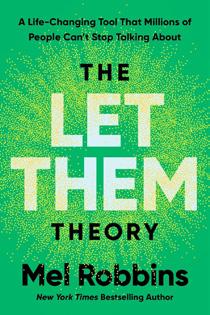
how this viral tool came to be, and teaches us how to apply it to eight key areas of our lives, with relatable stories and wisdom from experts in the field.
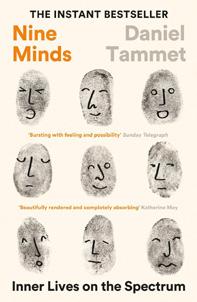
Nine Minds: Inner Lives on the Spectrum by
Daniel Tammet
From a surgeon to a bestselling novelist, Nine Minds delves into the extraordinary lives of nine men and women from around the world who have one thing in common: they are all neurodivergent. In sharing their experiences and how they view the world, it shatters stereotypes and celebrates the beauty in what sets them apart.

Dogs and Their Humans: Stories of Healing by
Noel Fitzpatrick
The love we have for our pets is incomprehensible, and Noel Fitzpatrick knows this only too well as a veterinary surgeon of 30 years. Sharing stories of healing and hope from his practice, including entertaining ones which will make you laugh out loud, the book is a true testament to just how profound this connection is.
Why do we procrastinate rather than push through unavoidable tasks? Expert columnist Steve Maher reveals the connection between anxiety and procrastination, and how we can overcome it
Around 50 metres above the Kawarau River, in New Zealand, a scene played out that will be forever etched in my memory. A young man was readying himself to jump off the Kawarau Bridge. Thankfully this was someone trying to have fun by bungee jumping, rather than a serious incident. But the poor fellow was still suffering anguish. The top half of his body was attempting to jump and saying ‘Yes let’s do this,’ but his feet firmly planted themselves into the platform, saying ‘Absolutely no chance.’
Clearly, it was right to feel anxious when jumping off a 50-metre high board with just a rope attached, and a distant river below. But these internal battles might sound all too familiar, and sometimes rage within us when we are trying to do more simple, safe tasks in daily life. Essentially, this comes down to procrastination, with the delaying tasks you need to do causing frustration for so many of us. So, why do we have this annoying habit?
Why do we procrastinate?
I once had a flat mate who was an arch-procrastinator. His motto was ‘Why put off today what you can put off tomorrow.’ I suspect his issue was a lack of motivation,
but for many this isn’t the case – the root cause tends to be anxiety driven. However, there can be many reasons people procrastinate:
• Too many inputs. Working memory is the ability to temporarily store and manipulate information in the mind to complete a task. Too many inputs can overwhelm our brain, so it can’t cope. Basic functions, like decision-making, become much harder. Steve Jobs famously wore the same black turtleneck every day so he didn’t waste cognitive effort on deciding what clothes to wear – in turn saving his mental capacity for bigger decisions.
• Uncertainty. Brains do not like uncertainty. As well as being adept at matching patterns, they are prediction machines. So, when they can’t foresee an outcome, our brains have a propensity to freeze.
• High standards. It’s common for people with high expectations of themselves to struggle with procrastination. If something is important to you, there may be a tendency to hold back from starting, as you worry that you might not meet the standards you’ve set for yourself.
• Negative outcomes. Our imagination is essentially our
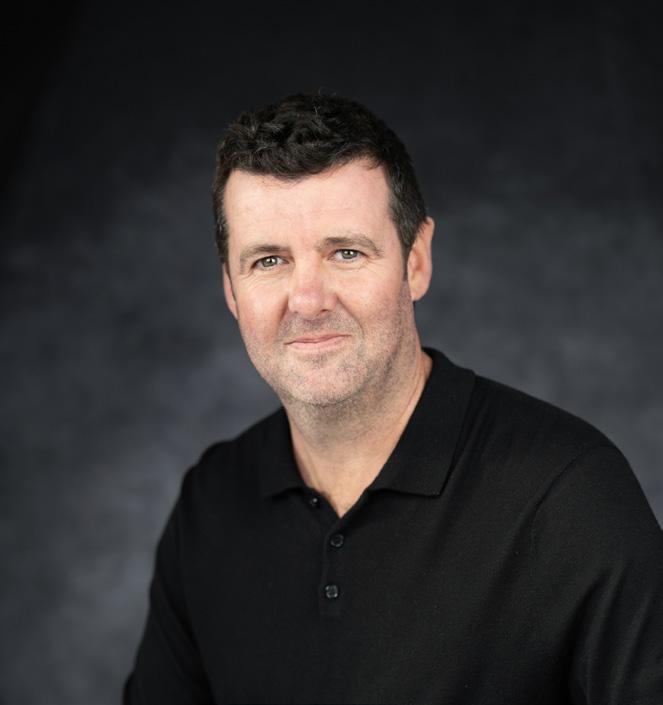
Maher is a consultant, professional coach, psychotherapist, and writer. Connect with him via the Life Coach Directory.
ability to predict the future. It’s a fantastic tool, but often biased towards the negative to protect ourselves from potential harm, and can lead us not to attempt things due to a fear of failure.
So, why does the brain work like this? One explanation is that it is trying to protect us. The dominant part of the brain is the limbic system, which is its emotional centre. A key player in this is the amygdala, which is always seeking to protect us from threat. When we feel threatened, the amygdala triggers the fight, flight, freeze response. So it’s possible that when we are overwhelmed, struggling with uncertainty, or there’s a fear we may fail, the brain goes into freeze mode. But the important distinction here is that our brain can’t recognise what is a genuine threat to our safety, and

an imagined one, and therefore reacts the same regardless.
Psychologist Daniel Kahneman provides another explanation in his classic work, Thinking Fast and Slow. He describes the brain as having two systems: system one operates automatically and quickly, with little effort; system two is more demanding and requires a lot more mental effort. Daniel explained that when we have too much on our mind, or are worried about the outcome, system one will win out and we prioritise short-term gains (like scrolling social media) over longterm pain (studying for exams).
So, what can we do to help us take the metaphorical plunge, and ditch the procrastination?
• Chunking. Make the task easier for the brain to handle by reducing the load. As the saying goes: ‘How do you eat an elephant? One bite at a time.’ This encourages breaking a large task down into smaller, more achievable ones.
• The Zeigarnik Effect. Sometimes when I have to write, I find all sorts of reasons for putting it off. But Happiful has deadlines, so I can’t put it off forever. Author and journalist Oliver Burkeman suggested a brilliant technique
that, while paradoxical, works wonders: allow yourself only 30 minutes per day to write. At the end of the 30 minutes, I am usually in the flow and want to write more, but following the rules I must stop. The strange thing is that the next day, I am literally running to my desk to write more. This is known as the Zeigarnik Effect, and can apply to other tasks or ongoing things that you regularly put off.
• Overcoming inertia. If you can’t enforce the 30-minute cut off point, and you want to carry on with your task at hand – be that writing, a work out, or studying, – you may find yourself doing much more than you intended. Overcoming the effort and anxiety of getting started may be all you need to do to break through procrastination.
• Values alignment. Aligning your actions to your values has many benefits – for example decision making becomes easier by reducing cognitive load. Knowing your values, and how a task allows you to move towards them, will mean you are less likely to put things off because you’re connected to the end goal.
Procrastination is a frustrating trait that stops us getting stuff done. And while it can often be a result of our brain trying to protect us, leading us to take the easier option of doing nothing, sometimes we need to do what our bungee-jumping friend finally did after torturing himself for 15 minutes – which is to take the leap. Following my tips may just help you do that.
Say goodbye to sugary, shop-bought shots, and make these simple, nutrient-packed blends at home. Support your gut, reduce inflammation, and feel your best with just a few fresh ingredients
Writing | Evie Whitehead
You may have seen gut boost shots appearing in your local supermarkets with the knowledge that we should support our gut microbiome, however, lots of these branded products are loaded with sugars. Why not make your own and take back control of sugar content, by getting all the benefits to support your wellbeing without the price tag? To make these shots you can juice the ingredients, or, if you don’t have a juicer (like me), you can blend in your usual blender and strain through a fine mesh sieve.
Ingredients
• 50ml kefir
• 50ml coconut milk
• ½ cup (50g) mango

The healthy bit
Kefir is packed with billions of beneficial bacteria that help us to break down food and extract more nutrients. Plus, evidence shows that including fermented probiotic-rich foods can improve our health in multiple ways.
In a recent study, published in Probiotics and Antimicrobial Proteins, a three-week daily dose of kefir reduced abdominal pain, bloating, and appetite in 56 adults, and increased the abundance of total anaerobes.
In this recipe, mango and lime also provide vitamin C to support a healthy immune system, which is especially important at this time of the year.
Adding coconut milk provides medium-chain triglycerides – a saturated fat that is absorbed differently from others, helping to stimulate energy production. It can also help reduce harmful bacteria and yeast. (1–2 servings)
• Juice of 1 lime

(1–2 servings)
• ½ inch turmeric
• ½ inch ginger
• ½ cup (50g) pineapple
• 1 small carrot (no need to peel unless non-organic)
• Black pepper
Turmeric contains a compound called curcumin, which has been used for years for its anti-inflammatory benefits. Many scientific studies provide evidence of its ability to reduce inflammation in conditions such as arthritis, but it’s also good for fatigue and improving digestive health. The effects of curcumin are enhanced with the addition of piperine from black pepper.
Carrots contain beta carotene, which is converted to vitamin A inside our bodies. This is a key micronutrient needed for a healthy immune system, and there is truth in what they say about carrots helping you see in the dark, as vitamin A helps improve eye health.
Ginger contains gingerol, further supporting digestion as it stimulates bile production, as well as being a powerful antioxidant helping to mop up free radicals. Pineapple adds a lovely sweetness, but also a shot of antioxidant vitamin C.
(1–2 servings)
• ½ grapefruit or orange (about 4–5 segments)
• 1 beetroot (peeled or use 1 teaspoon of beetroot powder)
• 1/2 cup (50g) berries
• Optional: ½ teaspoon of spirulina
Dietary nitrate, from sources such as beetroot juice, lowers blood pressure via the nitratenitrite-nitric oxide (NO) pathway, but was shown to be even more effective with grapefruit juice added, as stated a 2021 in study published in the British Journal of Clinical Pharmacology.
Spirulina intake has also demonstrated powerful effects in decreased blood pressure and plasma lipid concentrations, especially triacylglycerols and low-density lipoproteincholesterol, according to a study in the Journal of Medicinal Food. These ingredients also support liver detoxification pathways, making this a great detox shot for liver support. But please note: do not take at the same time as medication as grapefruit can interact with absorption – if you are on medication, swap the grapefruit for an equally delicious orange. This is a great daily shot for anybody wishing to reduce their blood pressure naturally, and boost detoxification.
(1–2 servings)
• 1 large or 3 small tomatoes (remove the core of large tomatoes)
• ½ small yellow onion
• 50g cucumber (about ¼ of whole cucumber)
• ½ lemon, freshly squeezed
• ¼ red bell pepper (remove core and seeds)
• ¼ teaspoon sea salt
• Black pepper
• 1 small sprig of basil (about 3–4 basil leaves and stalk)
We’ve all heard about the benefits of the Mediterranean diet and how it can improve many areas of health, from dementia prevention to diabetes. This shot is based on the well-known, delicious Spanish soup called gazpacho – a tomato-based soup enjoyed chilled. This shot is a great way to get the benefits of the Mediterranean diet if you prefer a savoury shot rather than sweet. Consider saving two servings to enjoy it as a delicious lunch with a side of sourdough topped with avocado and mackerel. Yum!
Evie Whitehead is an experienced nutritional therapist specialising in gut health. Head to the Nutritionist Resource for more.

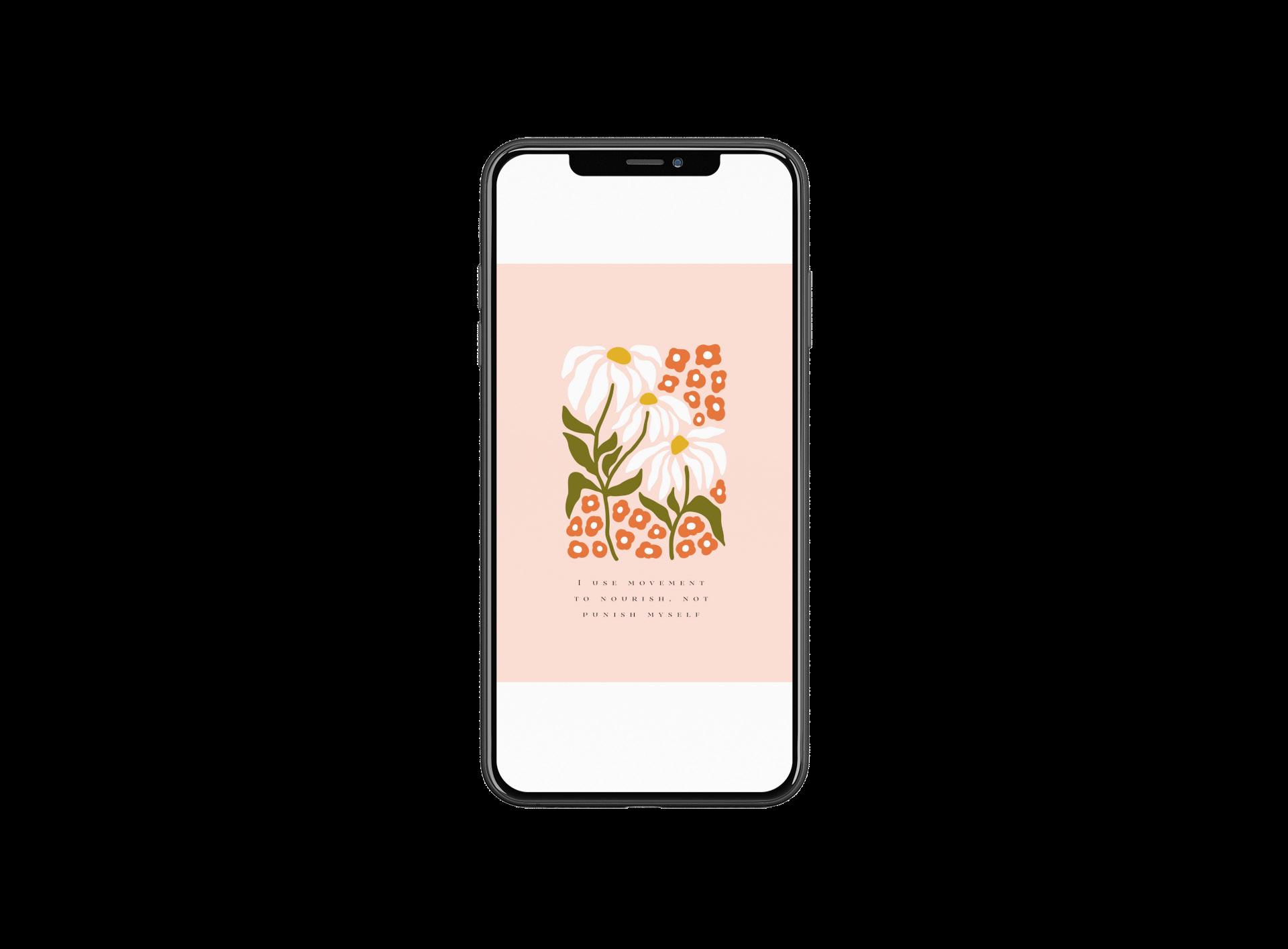



Beyond our award-winning monthly magazine, our shop hosts a range of creative items, designed to inspire, engage, entertain, and empower you, including:
Anti-anxiety guided journal
Self-reflection guide
Reflect & flourish: affirmation cards
Winds of change: 3-piece artwork collection
Question of thought: puzzle booklet
DIY self-care booklet

From our print journals helping you gain a deeper understanding of your true self, to our digital downloads featuring uplifting sentiments and actionable advice, continue your wellbeing journey with us.
It’s time to get real about this commonly misunderstood condition
Writing | Becky Bowden
Myalgic encephalomyelitis (ME), also known as chronic fatigue syndrome (CFS), is a debilitating condition that can affect the nervous and immune systems and, according to the ME Association, affects at least 250,000 people in the UK. Characteristics associated with this illness include severe and ongoing fatigue that doesn’t ease with rest, brain fog, headaches, and sleep problems.
As someone who has been living with chronic fatigue syndrome for many years now, I’m familiar with the harsh realities of navigating life while trying to manage my symptoms. I was first diagnosed with chronic fatigue syndrome and other health issues during a traumatic time in my life, in which I lost my father to cancer and suffered a stillbirth within a very short space of time.
A systematic review, published in Psychosomatic Medicine, has suggested a possible link between
trauma or stress and functional somatic conditions such as CFS, but every person’s journey is unique and no two cases are exactly the same. With that in mind, there are also many myths and misconceptions associated with chronic fatigue syndrome, so, let’s debunk some of them now, together.
Chronic fatigue syndrome is far more complex than just ‘feeling tired’ in the normal sense of the word. People with CFS feel regularly and profoundly fatigued. This fatigue never seems to improve, even with rest.
Life with CFS, for most people, means a constant struggle to sleep and we rarely wake feeling truly refreshed, even after many long hours of slumber. In my personal experience, I have found that I often feel completely exhausted by 4pm, yet when I
try to get an early night, sleep doesn’t come easily, and I can spend hours tossing and turning before eventually drifting off. Many of those with CFS (myself included) also have vivid dreams and may struggle to lie in, waking early and being unable to get back to sleep. This type of ongoing and prolonged fatigue is very different from a general feeling of tiredness, and can severely impact daily life.
Life with chronic fatigue is more complex than some may realise. Although fatigue is, of course, one of the main symptoms of CFS, many other issues go hand in hand with this illness. These include:
• Problems with concentration and memory. People with chronic fatigue syndrome may have difficulty concentrating or remembering details. Some people describe a feeling of ‘brain fog’. >>>
Chronic fatigue syndrome affects at least 250,000 people in the UK

• Problems sleeping. Falling asleep can prove difficult. There may also be issues with restless sleep and vivid dreams.
• Painful muscles and joints. Painful muscles, joint pain, and spasms can all be experienced by those with CFS.
• Sensitivity to taste, light, sound, touch, and smell. Adapting to new surroundings can be difficult for some. Certain lighting and noise levels can be overwhelming.
• Issues with temperature. Hot flushes or cold chills can seemingly occur out of nowhere, leaving us feeling flustered and uneasy.
• Heart palpitations. Fast and irregular heartbeats can often be one of the CFS symptoms.
• Flu-like symptoms. Many people also experience flu-like symptoms and dizziness.
Myth three: CFS can be diagnosed with a simple test
A common myth is that your GP will be able to diagnose chronic fatigue syndrome with a blood test, or by using specific markers. In reality, CFS is diagnosed using a detailed evaluation of the patient’s medical history and symptoms. Guidelines from the National Institute for Health and Care Excellence (NICE) say doctors should consider diagnosing ME/ CFS if all the following apply, and are not caused by another condition: fatigue (extreme tiredness); sleep problems; issues with thinking and concentration; and symptoms that are made worse by physical or mental activity.
Blood tests are often performed to rule out other underlying conditions, such as anaemia or an underactive thyroid. The process of obtaining a diagnosis can often be a long and frustrating one, but your doctor will be able to advise how to manage your symptoms in the meantime.
Myth four: People with chronic fatigue syndrome aren’t reliable workers
It may be wrongly assumed that those living with chronic fatigue don’t make reliable workers. This is a myth that must be debunked. If, or when, an individual feels up to doing so, work can provide those with CFS a sense of purpose and responsibility, helping them to feel valued. With support from occupational health teams and HR departments in the workplace, as well as regular contact with our GPs, we can be an asset to any team. I have found that freelancing and setting my own hours is something that works well for me, as I can take a break when needed.
Myth five: Nothing can alleviate the symptoms of chronic fatigue syndrome
In a bid to dispel this myth, I spoke with Dr Deepali Misra-Sharp, who is an NHS GP.
“CFS is a condition without a definitive cure, but it’s a misconception to think that symptom relief is impossible,” Dr Misra-Sharp explains. “As a GP, I often advise patients on practical, evidence-based approaches that can provide meaningful improvements in daily functioning and quality of life. According to the latest NICE guidelines [2021], managing CFS/ME is centred on personalised care plans that reflect each patient’s unique needs, as the severity and symptom presentation can vary widely.”
CFS is a condition without a definitive cure, but it’s a misconception to think that symptom relief is impossible
Dr Deepali Misra-Sharp shares that recommendations include pacing and maintaining an ‘energy envelope’ – essentially balancing activities with rest to avoid post-exertional malaise (PEM), a common symptom where physical or mental exertion leads to a significant worsening of symptoms. Cognitive behavioral therapy (CBT), not as a cure, but as a means of managing the emotional strain and anxiety that often accompany chronic illness, is also recommended, along with sleep hygiene and lifestyle adjustments, and nutrition and managing co-existing conditions. As the ME Association highlighted that the number of cases of CFS could be on the rise (in part due to its relationship to long Covid), it’s about time that we busted some of these common myths for good, so individuals and their loved ones can make informed, evidence-based decisions about their next steps.
Recognising the value of ‘in-between’ periods in life, and how to change our perspective on them
Writing | Michelle Elman
If you do life right, most of the time, it should be boring. Of course, life comes with high highs and low lows, but the middle part should be stable, constant, and certain – which can come across as a little dull at times. In particular, the period following a high can often be interpreted as a ‘lull’ in contrast, when the truth is that quiet doesn’t equal lull. I like to think of these gaps in time as the most precious moments, where I can maximise life if I take advantage of them fully.
I find it helpful to imagine these time periods like when you’re sitting on the bench in team sports. You haven’t been put on the bench because you are bad at it, you are there so that you can get a break, catch your breath, and pick up a little energy. It’s so that when it’s your time to get back out there, you are ready to go at life with full force.
If you spend the entire time sitting on the bench, whinging and whining, with the attitude “Why does everyone else get to play and I don’t?” you’ll be wasting your time on the bench. If you are so desperate and impatient to get out there, running on the spot, jumping up and down, and yelling at the rest of the team, not only are you consuming energy, but you’re also consuming it without results. It won’t expedite the process, and get you on the field quicker. Most likely, you will end up regretting that you spent the time feeling frustrated and ungrateful for the break. So, instead, focus on using that time to hydrate, stretch out any sore muscles, and have a team or tactical chat. Regroup with your coach, and then, when it’s game time, you’ll know you spent your break wisely.
It’s very easy when you are being benched to think of it
as a punishment – worrying and spiraling into believing you’re never going to be able to play again. I know this fear as a freelancer. If I ever have a quiet month, I worry that all the work has dried up, and I will never work again. In a decade of working for myself, that has (thankfully) never been true. All it does is make me stressed out, suffering throughout the entire duration of the quiet patch. With my, now many, years of experience, I have come to recognise my career has a pattern of either being boring or too busy, with rarely any middle ground. Therefore, when I hit a ‘boring’ patch, I ensure I take the time to appreciate it. I try my best to maximise the amount of rest I can get in that period, because I know it’s not going to last long. When my career has a lull, I put my time and energy into my social life and

relationships, so that I know I am feeding those areas of life, too – especially as they’re harder to give time to when work is busy. If we can stop focusing on the area of life where we feel like we are lacking in the current moment, we are able to recognise that we can use our energy to fuel other areas instead. The reality is that it’s very rare in life to have every area working perfectly simultaneously, and so we are allowed to focus on one space at a time. When one area is thriving and doesn’t need your focus, turn your attention somewhere else.
Ultimately, this obsession with life’s lulls often stems from capitalism, and the messaging that we need to be forever productive. That if we aren’t always in ‘GO!’ mode, we aren’t good enough, or trying hard enough. But rest, relaxation, and breaks are essential, and so we must try to detach our self-worth from our productiveness in order to reduce the guilt we feel during every moment of calm.
With the promotion of hustle culture, we have this idea that even when it’s quiet we must always be striving for more,
and aspiring to greater and higher goals – but that leads to destination addiction. That’s where we are never stopping for a moment to look back, and recognise or appreciate all that we have achieved. When we are always on to the next thing, it’s important we stop and reevaluate – why am I constantly striving and searching for more? Why is it inherent within people? Try to take a moment to be grateful for what’s been achieved, and, most importantly, celebrate the wins! We want to take a moment to be proud of ourselves, and, as a result, reward ourselves with a time to collapse, rest up, and even spend a day in bed. We all need a duvet day once in a while, and you don’t have to earn your right to it by burning yourself out first. It’s OK to pause, stop, and appreciate the view for a moment, so it’s time we relabeled the ‘lull’. It’s simply a pitstop, and we all need that time to refuel and take stock!

Michelle Elman is a dating and boundaries media expert. Listen to her podcast, ‘In All Honesty’, available on all major streaming platforms.

You don’t have to be great to start, but you have to start to be great
Explore four popular journaling styles to discover the one that most resonates with you
Writing | Lydia Wilkins
Whether it is contained in a simple, unassuming notebook or comes covered in personalised stickers to express yourself, journaling has long been a staple pastime for many. Within the pages, there can be elaborate designs that take hours to sketch out, endless deep thoughts and questions to yourself, or just simple lists noted down – but, somehow, all styles help us to make sense of the world around us.
The act of journaling can be incredibly personal and individual, but there are also specific methods that could be of use, too. Naturally, this begs the question: which one best suits your specific goals?
Here, we’re exploring four popular methods of journaling, looking at how to set yourself up to get the most from the activity, as well as understanding the unique benefits they offer. Each technique can support you in different ways, but it can take some trial and error to find out what works best for you. So, what’s on offer?
If you were on social media around 2013, then you may be aware of the viral moment bullet journaling had. Countless blogs and social media pages were dedicated to sharing stunning spreads, with perfect aesthetics that seemed to require excellent penmanship and creative eyes.
Searching for inspirational images might have made you think this approach was unobtainable and intimidating, however, that’s not the case. All you need is a notebook, a pen, and maybe a ruler – and a reminder that a creative outlet is allowed to be imperfect. The brainchild of Ryder Carroll, the modus operandi of this journaling method is to ‘track the past, organise the present, and plan for the future’. This is all done using ‘bullet points’ or lists. The notebook is divided into specific sections with themes such as ‘goals’, ‘finances’, or ‘gym tracker’ – but can be more personalised to your taste, with things such as reading trackers and reviews, or TV show ratings. >>>
Another key part is setting up a ‘future log’, which is where you can plan and track upcoming tasks and events – you could do this daily, weekly, or monthly. But the fun part is using colour and design to unleash your creative side, and make the pages appealing to you. There are no rules on imagery or styles you have to follow; it’s a chance to experiment and express yourself. Overall, each bullet journal is
customised to you; a multiplicity of needs managed on paper, as well as being a place to process your thoughts and emotional inner universe. For inspiration and guides, visit bulletjournal.com.
This daily practice entails writing three pages of long-hand stream of consciousness, as a way to start your day. Simply commit pen to paper without second-guessing.
There’s no need to overwork it, or intellectualise what you log on the page. Just let it flow.
Julia Cameron is the creator of this method of journaling, as outlined in her hugely popular book, The Artist’s Way. The idea of writing out your stream of consciousness first thing in the morning is to prevent your ego from ‘getting in the way’ – letting go of weighty worries, thoughts, intricacies, and other blocks.
This kind of journaling can be very freeing. Some days, you may surprise yourself with what comes out on the page in these moments. On others, you may find that you have a complete block and can only manage to put down ‘I don’t know what to write’ over and over again. Both scenarios achieve the same thing: to get your brain moving, and to allow yourself to work through whatever is going on inside.
Gratitude journaling can come in a variety of formats, but the basic idea is to record the things that you are thankful for. You could focus on a specific area in your life, such as work, your relationship, or your health – or you could simply write down all the things that you appreciate about the day or week. It could be a brief list, or you could expand on each point and explore what it means to you. Even if it’s just something small – such as a friend sending you a check-in message at the end of a long stressful week – this is an opportunity to sit with your feelings.
As for wellbeing benefits, the positive impact of gratitude journaling has been welldocumented, supporting everything from depression to stress and anxiety – but that’s not all. A 2021 review of research published in the Journal of Positive
Keeping a gratitude journal can lead to a significant drop in diastolic blood pressure
The idea is very simple: take just five minutes of your day to fill out the prompts. Alex and Mimi Ikonn are the creators of the journal and, according to their website, more than two million copies have been sold so far.
Psychology found that keeping a gratitude journal can lead to a significant drop in diastolic blood pressure and, in fact, even just having grateful thoughts could help slow your heartbeat, and regulate your breathing.
The Five-Minute Journal Favoured by celebrities such as Emma Watson (see her ‘What’s In My Bag’ interview for Vogue), The Five-Minute Journal is designed to help you tune-in to the power of positive psychology for six months.
This setup is all about building a habit over the course of six months, by which time you will need another journal. Your daily practice will log three things you are grateful for, what made that day great, a daily affirmation, three highlights of the day, and space to record any lessons learned that day. You can order yourself a copy of the muchloved journal from intelligentchange.com. You can also take inspiration from the technique and adjust it to suit your specific needs. For example, you could change the daily questions to something that suits your current goals, or to highlight areas of wellbeing that you want to explore more going forwards.
Not every journaling technique will work for every person, which is why finding a method that resonates with you is vital. And when you consider the benefits journaling can bring for both our physical and mental wellbeing, it’s worth finding one that works. So, which will it be for you?

Save on money and stress with your own mini retreat
Writing | Holly Treacy-West
There’s nothing quite like a spa day: the soothing scent of aromatherapy oils, the fluffiest towels you’ll ever wrap yourself in, and the utter bliss of someone else melting away your tension with expert hands.
Through life’s ups and downs, many of us crave that same sense of calm and comfort – but without the price tag. Luckily, with a little creativity, it’s easy to transform your home into a cosy oasis of relaxation. Think of it as the perfect self-care ritual, bringing spa-worthy vibes to your everyday spaces.
We turned to Georgina Hemsley, Reiki master and founder of beauty brand Hemsley Organics, to ask for her top tips for creating an at-home retreat.
1. Set the mood
Creating your home spa doesn’t need to be complicated – it can start with something as simple as lighting a scented candle or spritzing a calming room spray. But for a truly transformative experience, consider using scents rooted in aromatherapy.
“Lavender is renowned for its soothing aroma,” shares Georgina. “It helps to calm the mind and reduce anxiety,
making it a staple for promoting deep, restorative sleep. Jasmine adds a delicate floral touch, uplifting the mood and helping to balance emotional stress, while camomile – cherished for centuries – gently eases tension and prepares the body for rest. Finally, cedarwood, with its warm, grounding base notes, stabilises emotions and enhances mindfulness, encouraging a deeper sense of relaxation.”
To make the most of these scents, try a pillow mist infused with essential oils, a sleep balm for your night-time routine, or a facial oil to massage into your skin before bed.
Transforming your skincare routine into a spa-worthy experience is one of the easiest – and most rewarding – ways to pamper yourself at home. You don’t need the latest products or gadgets – all it takes is a little intention and extra care.
Start by cleansing to gently lift impurities, leaving your skin soft and refreshed. Follow with a hydration mist to prepare your skin to absorb the nutrients in the next steps. Georgina
recommends using an eye serum, applying it with light tapping motions using your ring fingers. “Incorporate a mini massage to reduce puffiness and awaken tired eyes,” she suggests. Next, smooth a face serum over your skin, focusing on areas where you feel tension, and finish by sealing in moisture with a rich day or night cream. This final step locks in hydration and leaves your skin glowing and rejuvenated.
Running a bath in 2025 is so much more than tossing in some Radox. It’s a chance to cocoon yourself in an environment that feels like an emotional hug.
Transform your soak into a ritual by adding Epsom salts to ease muscle tension, dried flower petals for a touch of indulgence, and essential bath oils to envelop you in soothing scents.
For an extra layer of relaxation, surround yourself with flickering candles and grounding crystals. Pair it all with a calming soundtrack – whether it’s soft piano, ocean waves, or your favourite chill playlist – as you immerse yourself in the warm, soothing water.

Did you know you can create a luxurious scrub using simple ingredients from your kitchen? Georgina suggests this easy recipe: mix one tablespoon of salt or coconut sugar with a small amount of a moisturising balm to create a gentle, exfoliating scrub.
To elevate the experience, follow it with a soothing mini foot massage:
• Start with your toes. Use circular motions to gently work the scrub into the skin.
• Focus on your arches. Apply firm pressure to relieve tension and promote relaxation.
Running a bath in 2025 is so much more than tossing in some Radox
• Massage your heels and ankles. Use upward strokes to boost circulation and soothe tired muscles.
• Rinse your feet with warm water, pat them dry, and enjoy the feeling of soft, nourished skin and total relaxation. The natural texture of the scrub, combined with the comforting warmth of your touch, makes this a delightful at-home spa ritual.
As you sink into your warm bath or relax with a face mask, why not add a moment of meditation? Georgina suggests self-Reiki, a simple yet powerful practice of placing your hands over your heart or any area that needs support.
“You don’t need to be trained in Reiki to benefit,” Georgina reassures. “We are all connected to universal energy. Simply set an intention and visualise healing energy flowing through you.”
This combination of meditation and self-reiki enhances inner peace, while the soothing warmth of your hands and the calming aroma of essential oils create a truly restorative experience. “It aligns your mind, body, and spirit,” Georgina explains, “transforming a simple self-care moment into a holistic escape.”
Try these wellbeing-themed challenges, if you dare…
When was the last time you felt proud of yourself?
What is something you crave at the moment? Is there anything you take for granted? What worries you about the future?
What is your relationship with yourself like at the moment?
What would it take for you to achieve your goals?
What is something you’re scared of? Is there something in your past you need to let go of?
Tell a friend what you value most about them. Give yourself a pep talk in the mirror.
Visit somewhere new, alone.
Perform a random act of kindness.
Next time someone breaks a boundary of yours, let them know. Write down three things you want to achieve in the next week. Ringfence an evening to devote to self-care. TRUTH DARE
Put your phone on do-not-disturb for a day.
Feeling safe in your own body is the foundation of mental and physical wellbeing, particularly for those experiencing chronic stress or post-traumatic stress disorder (PTSD). When the nervous system is stuck in survival mode – constantly scanning for threats, even when none are present – our body is flooded with stress hormones that disrupt everything from sleep quality to digestion, and mental clarity.
Over time, this internalised stress can lead to burnout, anxiety, and even physical illness. Learning how to feel safe in the body is a transformative skill. Nervous system regulation teaches us how to turn off that chronic fight-or-flight response, allowing the body and mind to rest, repair, and regain balance. So, how can we begin to find harmony? Here are five simple,
short exercises you can practise almost anywhere, to help bring your body and mind back to a state of safety and equilibrium.
Somatic grounding is a quick, effective way to reconnect with your body, and feel more secure in the present moment. When the nervous system is on high alert, the brain tends to dissociate from the body as a way to avoid discomfort. Grounding techniques bring you back into your physical sensations, which tell your brain that you’re safe. One simple technique is to stand or sit with both feet flat on the floor, close your eyes, and breathe deeply. Focus on the sensations in your feet – the texture of your socks or shoes, the pressure on the floor, and the temperature. Visualise your feet being supported by the ground beneath you. The more you

tune-in to the physical sensations of support and stability, the more your nervous system will receive the message that you are grounded, safe, and supported, offering a quick reset in stressful moments.
2.
Breathing exercises can shift you out of the fight-or-flight mode by activating the parasympathetic nervous system, which promotes relaxation and recovery. One effective practice is 4-7-8 breathing, a technique that can be done anywhere, anytime. This exercise is simple: inhale through your nose for four seconds; hold your breath for seven seconds; and then exhale slowly through your mouth for eight seconds. This pattern helps to lower heart rate, calm the mind, and induce a sense of safety and wellbeing. >>>
When the nervous system is stuck in survival mode, our body is flooded with stress

Repeating this for just a few minutes can bring you out of stress mode, and into a state of calm, signalling to your body and mind that it’s time to rest and recover. This exercise is especially useful during highstress moments, such as before an important meeting, or after an emotionally charged situation.
The vagus nerve plays a key role in regulating the nervous system, and helping you feel safe. When the vagus nerve is activated, it sends signals to your body that it’s OK to relax, shifting you from a state of survival to one of rest and restoration. A simple way to stimulate the vagus nerve is the vagal handhold.

Sit in a comfortable position and place one hand over your heart and the other over your belly. Close your eyes and take slow, deep breaths, feeling the rise and fall of your chest and abdomen. The combination of this gentle hand placement and conscious breathing helps to activate the parasympathetic nervous system, sending a powerful signal of safety to your brain and body. You can practise this for two to five minutes to quickly calm anxiety or overwhelm. Doing this regularly can build a stronger connection between your mind and body, reinforcing feelings of safety over time.
The ‘voo breath’ is a powerful vocalisation exercise designed to stimulate the vagus nerve, and bring a sense of calm to the body. To practise, take a deep breath in, and on your exhale, make a deep, resonant ‘voo’ sound, allowing it to vibrate through your chest and resonate deeply in your body. You should feel the vibration in your chest, particularly around your heart and lungs. Repeat this three to five times, making the sound as low and drawn out as possible. The deep vibration stimulates the vagus nerve and helps to calm the nervous system, promoting a sense of safety
and wellbeing. It’s an excellent practice for those moments when stress or anxiety feels overwhelming, offering a way to ground yourself quickly.
The five senses exercise is an effective way to orient yourself to the present moment, especially when feeling anxious or disoriented. This exercise helps to interrupt anxious thought patterns, and reminds your nervous system that you are safe in your current environment. By focusing on sensory details from your current environment, you can gently bring yourself out of fight-or-flight mode, and back into a state of calm. It involves briefly tuning-in to your five senses to ground yourself in the here and now. To practise, simply notice each of the following for 30 seconds: what can you see (after this step it can be helpful to close your eyes as you tune-in to the rest of your senses); what can you hear; what can you touch (feel); what can you smell around you; and what can you taste. Notice how your body responds as you tune-in to your senses. This practice works particularly well in stressful environments by choosing to centre yourself in the present and feel safe.
Karden Rabin is the co-author of ‘The Secret Language of the Body’ and co-founder of Somia International. Connect with him on Instagram @kardenrabin.

Spend a relaxing moment musing over these mindful puzzles
Unscramble the word in each of the three circles to discover the centre letter that links them all.
Can you decipher these classic catchphrases written in emoji form?
B I S
U L Y I A T T H


From an act of kindness helping unwell children to a lesson in the sweet sound of birdsong, explore these 10 recommendations to help your wellbeing thrive
Writing | Lauren Bromley-Bird
1
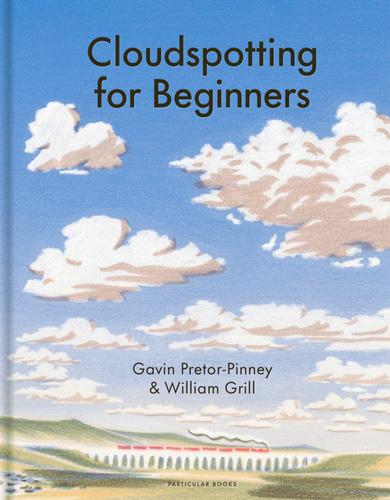
Cloudspotting for Beginners by Gavin Pretor-Pinney and William Grill
There is one mindfulness tool that stays with us wherever we go, and it lies in the sky above us: cloudwatching. Experts from the Cloud Appreciation Society have written a beginner’s guide for those who are inspired to try this slow-living hobby, where you can discover different types of clouds and how to identify them. (Out now, £20.00)
2
Have a laugh at a comedy club
3 4
Recycle your jewellery with WellChild
WellChild is a life-changing charity that makes it possible for severely ill children with complex medical needs to be cared for in the comfort of their own homes. When you donate unwanted or broken jewellery and watches, WellChild recycles them and uses the proceeds to help fund their mission. (Visit wellchild.org.uk for more)
‘That’s Helpful with Edwina Stott’ The premise of this self-improvement podcast is to leave listeners feeling like they’ve learned something helpful for their wellbeing, which can positively impact their life. Each episode unpacks one skill, hack, or idea backed by science, with podcast host Edwinda Stott and expert guests. (Available now on all podcast platforms)

They say laughter is the best medicine, and there’s strong evidence to prove this. According to the University of Warwick, laughing can help aid our wellbeing by alleviating worry, diminishing feelings of isolation, and more. So, if you’re looking to have a good belly laugh that leaves you feeling warm and fulfilled, head on down to your nearest comedy club. (Search for a local event near you)
5
Old Friend Club
Each video posted on the Instagram account ‘Old Friend Club’ is an interaction between a host and a retirement home resident who has seen it all and experienced so much. You’ll find wholesome conversations, life lessons, and plenty of chuckles. (Follow @oldfriendclub on Instagram)

7
As adults with a never-ending list of responsibilities, carving out time to read or learn something new can feel almost impossible, but it is doable with Blinkist. The app summarises teachings from books, podcasts, and experts into 15-minute insights so that you can feed your curiosity in smaller chunks of time.
(Find it on the app store)
Learn how to identify birdsong There’s something so delightful about waking up to the sound of birds chirping, but are you able to recognise which bird call belongs to which species? With Woodland Trust, you can learn how to identify the calls of some of nature’s most wonderful birds, from a chirpy robin to a rattling wren. (Find out more at woodlandtrust.org.uk)
9
Joy – The Birth of IVF
8
Finding the motivation to exercise can be challenging when going it alone, so why not partner up with an exercise buddy who has similar fitness goals to you? Having a trusted friend by your side is like having a personal cheerleader to keep you motivated and committed, and can make exercise less chore-like and more fun.
In recognition of a breakthrough treatment that changed the lives of so many women, the moving drama, Joy, takes us back to 1978 where we see the birth of the first IVF baby, and the 10year long journey behind it with the three pioneers who made it possible. (Available to watch on Netflix)
6 10
If your resolution is to become more eco-friendly this year, start small by swapping your current washing-up products to this plastic-free cleaning set. Included is a beech wood pot brush made from sustainably sourced wood with tampico plant bristles, a scented handmade dish soap, and a compostable Swedish dish cloth. (£16.95, www.battlegreen.co.uk)

For your chance to win, simply email your answer to the following question to competitions@happiful.com
Which of the following is an example of a zero-waste product?
a) Plastic cling film
b) Plastic water bottle
c) Reusable shopping bag
*Competition closes 31 March 2025. UK excluding NI entries only. Good luck!
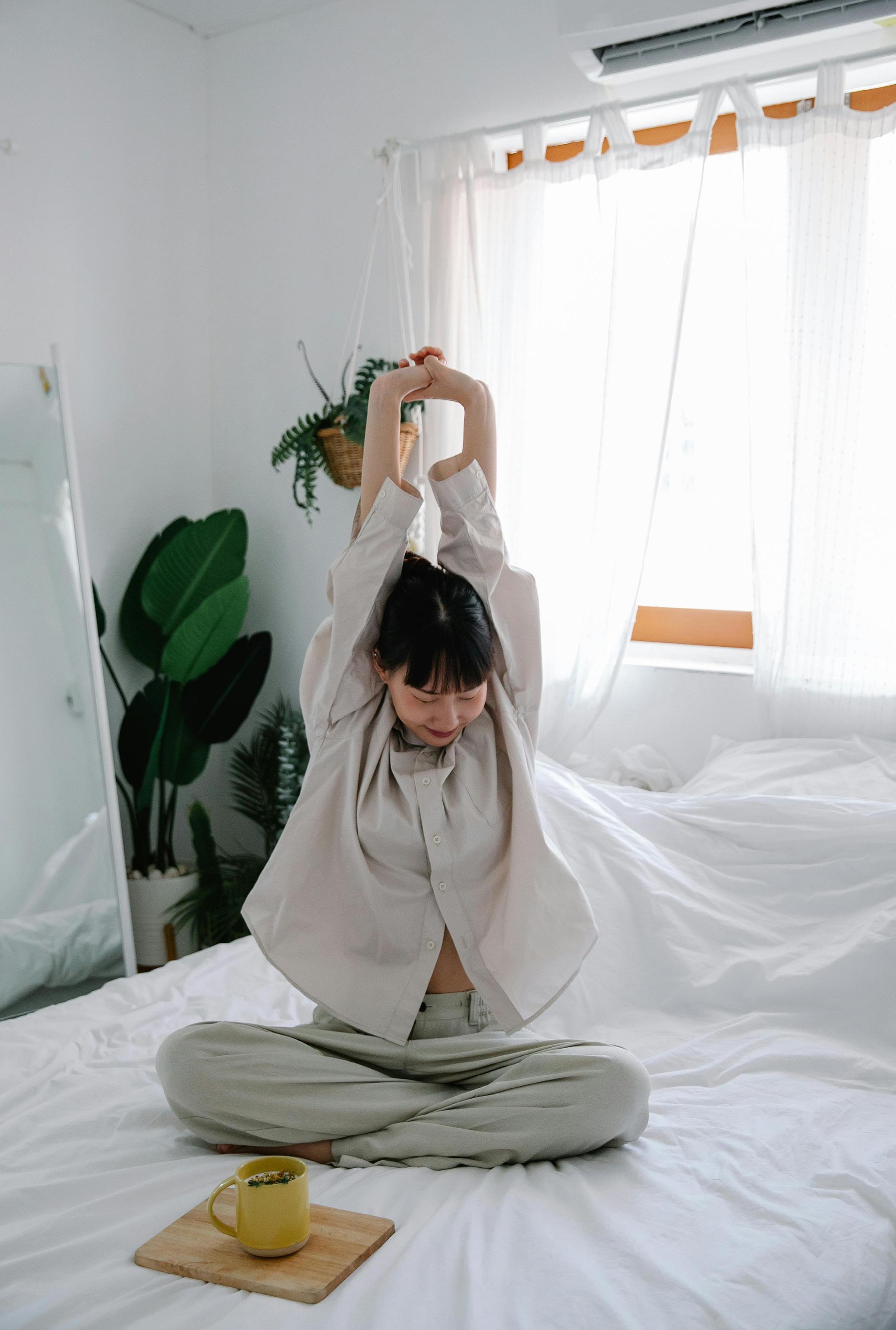
Rest easy with our expert advice on how to get a better night’s sleep
Writing | Fiona Fletcher Reid
Racing thoughts that refuse to quiet down, difficulty switching off, and a brain that seems perpetually wired, even when exhausted… If you have ADHD, then this might sound familiar. The result can be a challenging cycle where poor sleep intensifies attention difficulties during the day, and ADHD symptoms further disrupt sleep quality at night. This frustrating loop impacts cognitive function, emotional regulation, and overall wellbeing, but there is hope on the horizon. Follow these tips to reclaim restful nights.
1. Schedule worry time during the day
Because adults with ADHD often have difficulty controlling their attention and thinking, worrisome thoughts can contribute to restless nights. To prevent thoughts from hijacking your sleep schedule, clinical hypnotherapist Thea Martin has a novel suggestion: “Set yourself
specific ‘worry time’ each day, dedicated solely to issues you’re ruminating about, as it can really help you to free up your headspace, feel more in control, and reduce insomnia.
“Allocating a regular or set length of time can be challenging for those with ADHD,” Thea adds. “Some find incorporating it into an existing routine helpful –perhaps during the shower, or on their daily commute – or taking a more flexible approach as to time or location.”
2. Make relaxation your primary focus
Putting pressure on yourself to fall asleep can have a counterproductive effect, leading to frustration when things don’t go to plan. “Focus on relaxation, instead of sleep as your goal,” suggests Thea. This might involve placing your attention on the body as opposed to the mind, for example, by doing some light stretches or self-massage to relax tense muscles. Also think about what sensory aspects of your space need tweaking, perhaps by installing some blackout curtains, wearing an eyemask, or playing white noise sounds.
3. Write it down
If thoughts continue to plague your evening routine, try journaling before bed to release the need to ‘hold onto’ them. “Take a moment to list things you want to remember for the following day, and keep a pen and pad by the bed so that if something else comes to you, you can note it down,” says Thea.
“This helps to reduce cognitive load, encouraging our working memory to begin to unwind, trusting nothing is forgotten.”
4. Try hypnotherapy
Hypnotherapy provides a structured pathway to relaxation, and can help reduce anxiety, slow racing thoughts, and create deep relaxation. “Hypnotherapy can play to the strengths of the ADHD brain, providing a novel focal point for a busy mind,” explains Thea. “Working holistically with the body to move into a natural state of calm, hypnotherapy activates the parasympathetic nervous system, reducing stress hormones with immediate effect.” Find trained professionals on the Hypnotherapy Directory, or search online for recordings specifically designed for ADHD.
5. Create a bedtime routine
We know that people with ADHD can find routines boring, but hear us out on this one. “Sleep hygiene routines have been documented to really benefit those with ADHD, although something rigid and imposing can be difficult to stick to,” says Thea. Committing to a handful of repeatable actions – such as dimming the lights, listening to a relaxing playlist, or having a soothing bath – can signal to your brain that it’s time to rest. If you struggle with routines in general, you might consider setting reminders or creating an evening checklist, which helps you keep track and gives the satisfaction of crossing things off as you complete each task.

Thea Martin is a trauma-informed clinical hypnotherapist and integrative therapist. Visit the Hypnotherapy Directory to connect.
6. Don’t lie in bed if you can’t sleep
Follow the 30-minute rule: if you haven’t fallen asleep within half an hour, get up and engage in a calming, non-stimulating activity. Choose something genuinely relaxing like reading a physical book or listening to soft, quiet music. Critically, avoid screens completely. Not only do they activate your racing ADHD brain, they also emit blue light that suppresses melatonin, your natural sleep hormone. These devices essentially tell your brain to wake up when you desperately want the opposite. If you notice yourself starting to hyper-focus on any task, stop immediately. Return to bed only when you feel truly relaxed and sleepy, creating a healthy association between your bed and rest.
By implementing these strategies, you can gradually transform your relationship with sleep. Remember, progress isn’t linear, and what works one night might not work the next, but with these options hopefully you’ll always have a technique to try. Be kind to yourself, stay consistent, and keep going. Rest will come.
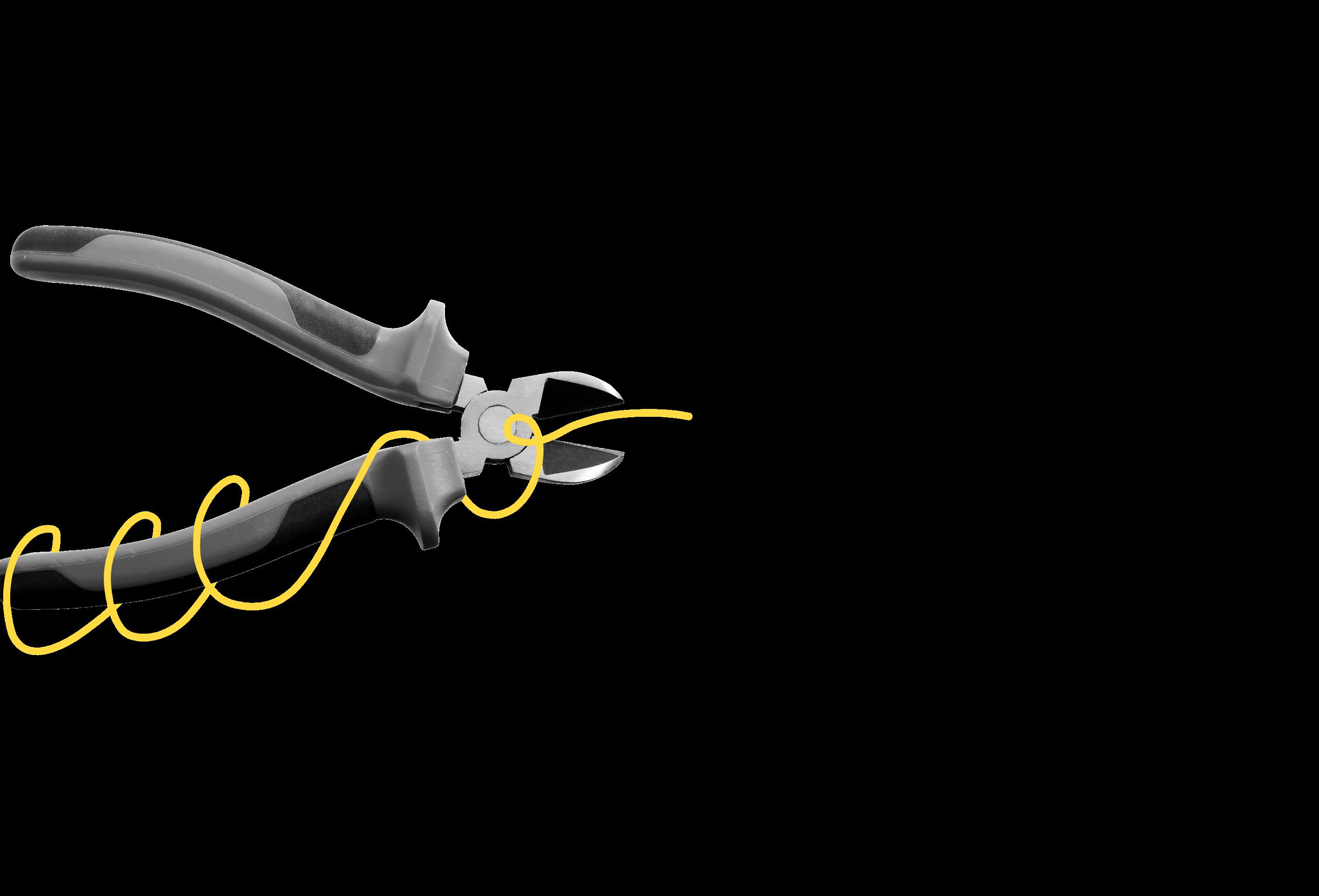
from three hours and 41 minutes in 2023), it’s clear our digital dependency is quickly spiralling out of control.
From doomscrolling to online banking, learning languages, and more, it’s hard to imagine a life where our phones don’t dominate our every day. But as studies increasingly show not just mental implications (like anxiety, depression, and stress) but also physical (poor posture) and emotional ones (low self-esteem), isn’t it time we reconsider our relationship with our phones?
Time, after all, is our most precious asset. Do we really want to look back on lives consumed by hashtags and influencers that offer little meaning or impact on how we truly want to live?
I’m just as guilty as the next person of spending too much time on my phone. I reach for it when I first wake up, doomscroll during the day when I should be working, and blatantly ignore the (on all accounts, quite generous) two-hour social media time limit I’ve installed in a bid to curb my addiction. I do it knowing how harmful it can be. I mean, who among us can honestly say they feel good after losing an entire afternoon to the ‘trad wife’ movement on TikTok?
The real issue with screen addiction is that it’s become so deeply ingrained in our lives.
It’s normal to see toddlers glued to iPads. It’s not unusual to see couples at fancy restaurants more absorbed in their phones than each other. And now, with wifi available on the underground and aeroplanes – once sacred, phonefree spaces – how on Earth do we break the habit?
As someone who no longer wants to be tethered to the constant bing, bing, bing-ing of notifications, I flew to Clinic Les Alpes, a rehab centre nestled in the Swiss Alps, to discover just how damaging our tech addiction has become – and what we can do to reclaim our attention and, more importantly, our time. Unlike other addictions, such as substance abuse or alcoholism, technology and screen addiction isn't currently classified as a medical condition. This lack of a


formal, diagnosable framework often makes it hard to know when your usage has crossed the line to problematic behaviour. But when I raised this concern before flying to Switzerland, the answer was simple: if you’re questioning whether your phone use is problematic, that means it probably is.
The reality is, many of us are spending upwards of six hours a day on our phones – a habit I’m guilty of myself. When you stop to think that this is nearly as much time as we spend sleeping, it’s clear our addiction has hit its peak. The constant pull of our devices, the endless scrolling, the infinite notifications – we’re
handing over swathes of our most valuable resource to tech bros driving Teslas. Naturallly though, recognising the problem is one thing; resolving it is another. In a world overwhelmed by technology, how do we navigate it while fostering a healthier relationship with our phones? >>>
During a session with Brittany Hunt, a clinician at Clinic Les Alpes specialising in addiction treatment, we delved into my relationship with my phone. While having access to an addiction specialist is a privilege that not everyone can afford, the process is pretty easy to replicate at home.
First, try identifying when and why you find yourself reaching for your phone. For me, it’s often when I’m procrastinating before a looming deadline. You might reach for your phone when you’re bored, stressed, or feeling lonely or anxious. Recognising the moments when you’re most prone to doomscrolling is the first step toward cultivating a healthier relationship with technology. If you’re feeling lonely, arrange to meet a friend for coffee. Stressed? Try doing a meditation or some mindful breathing.
Don’t be embarrassed to set boundaries to curb your phone usage. Brittany emphasises the importance of creating phonefree spaces. Rather than seeing this as deprivation, reframe it as dedicated time for yourself. You’ll soon notice a positive impact not only on your productivity, but also on the quality of your relaxation. During my stay in Switzerland, equine therapy and a forest hike were cancelled due to heavy fog and rain, so I opted for art therapy and a stretching class instead. These hands-on activities required presence and mindfulness, serving as the kind of distractions we should seek out more often as a way to spend time away from our phones.
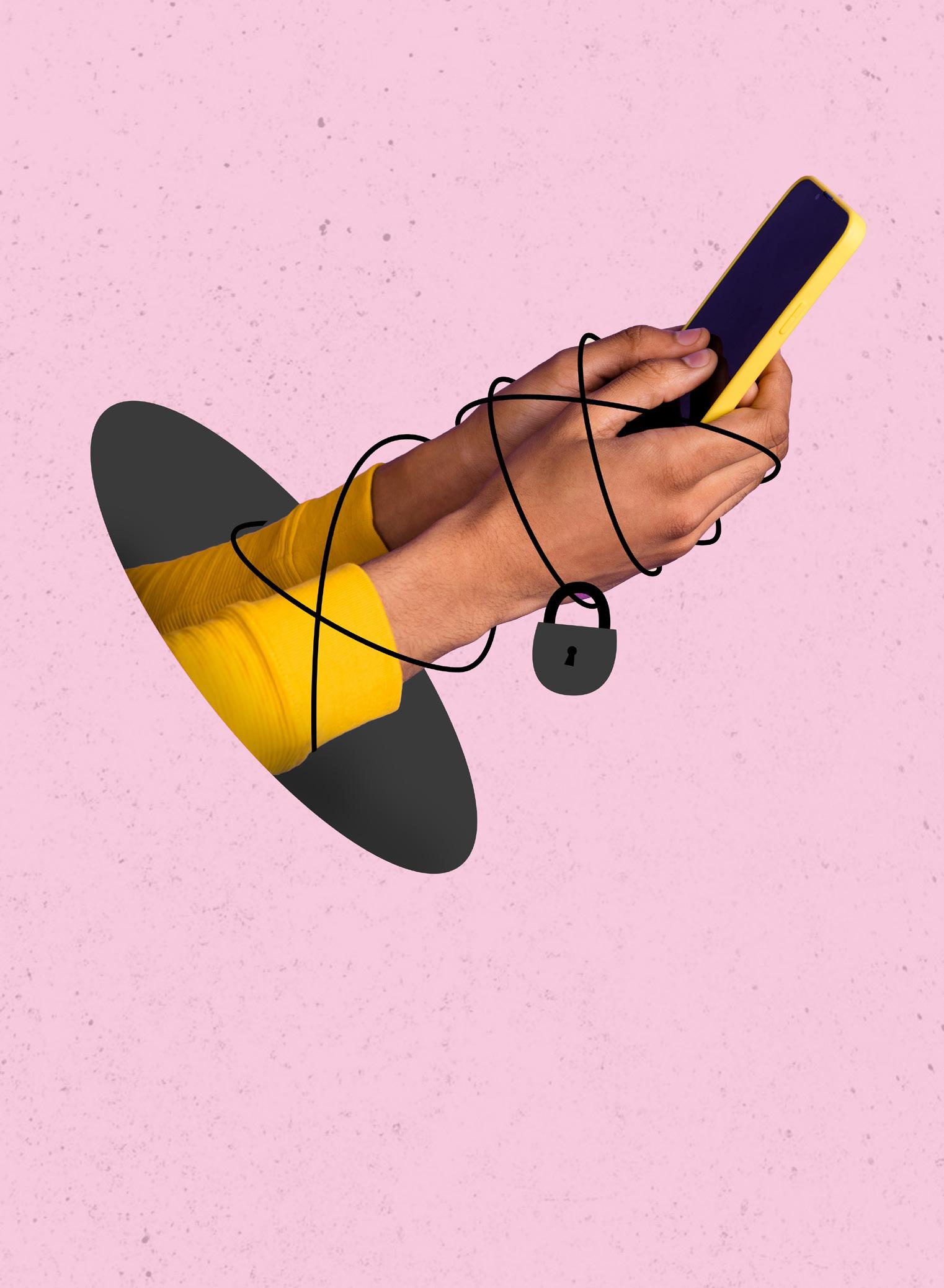
The issue with screen addiction is that it’s become so deeply ingrained in our lives
Patrick Wilson, founder of Clinic Les Alpes, has a sage question for anyone reassessing their relationship with their phone: “What price are you willing to pay?” he asks. Because, let’s face it, many of us suffer from poor sleep, heightened anxiety, and strained relationships with loved ones, all for the sake of mindless scrolling. He emphasises that building a healthier relationship
with our phones requires setting realistic goals and embracing small, gradual changes rather than striving for perfection. By adopting these strategies, we can reclaim our time and wellbeing, paving the way for a more balanced reality, one rich with appetite and wonder, rather than succumbing to life eagerly waiting for the next notification on our phone.
Looking for support with your mental health?
Here are some places that can help:
If you are in crisis and are concerned for your own safety, call 999 or go to A&E
Call Samaritans on 116 123 or email them at jo@samaritans.org
SANEline
SANEline offers support and information from 4pm–10pm: 0300 304 7000
Mind
Mind offers advice Mon–Fri 9am–6pm, except bank holidays: 0300 123 3393. Or email: info@mind.org.uk
Switchboard
Switchboard is a line for LGBT+ support. Open from 10am–10pm: 0800 0119 100. Or web chat: switchboard.lgbt
Those affected by self-harm (including friends and family) can find support at harmless.org.uk

• Pass me on to a friend who might appreciate some articles.
• Get crafty and use me for a vision board or collage.
• Keep me on a coffee table to pick up when you need a boost
• Remember I’m 100% recyclable, so pop me in your recycling bin.


INFORMATION ON CHRONIC ILLNESS
For information, signposting, and support visit meassociation.org.uk or call 0800 538 5200
RESOURCES FOR ADHD
To access advice and services from the UK’s leading neurodiversity charity, visit adhdfoundation.org.uk
Our two-for-one tree commitment is made of two parts. Firstly, we source all our paper from FSC® certified sources. The FSC® label guarantees that the trees harvested are replaced, or allowed to regenerate naturally. Secondly, we will ensure an additional tree is planted for each one used, by making a suitable donation to a forestry charity. Happiful is a brand of Memiah Limited. The opinions, views and values expressed in Happiful are those of the authors of that content and do not necessarily represent our opinions, views or values. Nothing in the magazine constitutes advice on which you should rely. It is provided for general information purposes only. We work hard to achieve the highest possible editorial standards, however if you would like to pass on your feedback or have a complaint about Happiful, please email us at feedback@happiful.com. We do not accept liability for products and/or services offered by third parties. Memiah Limited is a private company limited by shares and registered in England and Wales with company number 05489185 and VAT number GB 920805837. Our registered office address is Building B, Riverside Way, Camberley, Surrey, GU15 3YL.





